
The Project Gutenberg eBook of Furniture upholstery for schools, by Emil A. Johnson, B.S., A.M
Title: Furniture upholstery for schools
Author: Emil A. Johnson, B.S., A.M
Release Date: March 21, 2023 [eBook #70339]
Language: English
Produced by: Bob Taylor, Charlene Taylor and the Online Distributed Proofreading Team at https://www.pgdp.net (This file was produced from images generously made available by The Internet Archive)
[Pg 1]

By
EMIL A. JOHNSON, B.S., A.M.
Assistant Professor of Manual Arts.
Bradley Polytechnic Institute,
Peoria, Illinois

THE MANUAL ARTS PRESS
PEORIA, ILLINOIS
1919
[Pg 2]
Copyright, 1919, by
Emil A. Johnson
[Pg 3]
The purpose of this book is to give information concerning the methods by which upholstery work may be successfully carried on in school shops. The added beauty and comfort given to furniture by upholstery makes work of this character worth while. If period furniture is to be reproduced or modified, the worker must understand the art of upholstering.
The tendency to reproduce or copy good old pieces of furniture should be encouraged, for only in this way may a student obtain a proper background, from which may be developed a new style. New ideas, derived from the best of the old, are likely to serve humanity in the best way.
The study of the art of upholstery is an interesting one. It leads into many avenues of interest and profit, such as the history and methods of weaving; the processes of tanning and coloring; the manufacture and history of textiles; and the like. Such correlation is valuable, and each is distinctly educational.
I wish to acknowledge my indebtedness to Prof. Chas. A. Bennett for valuable suggestions and inspiration; to David H. Tingwall for valuable help, and photographs; to A. C. Newell for suggestions on the outlines; to Wm. F. Tuttle for the photographs of antiquarian furniture taken at the Art Institute of Chicago; to Bessie Bennett for certain information about the furniture; to John R. Fasier for the drawing in Fig. 28; and to my former and present Bradley students for inspiration and help.
The practical contents have been verified and corroborated by Henry Euler, a practical upholsterer for fifty-nine years, and by Herman Schwartling who has followed the trade for thirty years.
EMIL A. JOHNSON.
Peoria, Illinois, February, 1919.
[Pg 5]
| PART I | ||
| PAGE | ||
| Chapter I. Historical | 7 | |
| Chapter II. Tools and Materials | 11 | |
| Tools | 11 | |
| Materials | 11 | |
| PART II | ||
| UPHOLSTERY WITHOUT SPRINGS | ||
| Chapter III. Upholstering Board Structures | 16 | |
| A Low Footstool | 16 | |
| A Cart | 17 | |
| A Leg Rest | 17 | |
| A Footstool | 21 | |
| Materials Required | 23 | |
| Chapter IV. Upholstering Chair Seats | 24 | |
| A Chair Seat | 24 | |
| A Set-in Seat | 27 | |
| Chapter V. Upholstering a Framed Structure | 28 | |
| Footstool | 28 | |
| Procedure | 29 | |
| Materials | 36 | |
| Order of Procedure | 37 | |
| Different Methods | 37 | |
| PART III | ||
| UPHOLSTERY WITH SPRINGS | ||
| Chapter VI. Making a Hard-edge Seat | 38 | |
| Method | 38 | |
| Process | 40 | |
| A Queen Anne Stool | 47 | |
| Chapter VII. Re-upholstering | 50 | |
| Old Furniture | 50 | |
| Chapter VIII. Spring-edge Upholstery | 53 | |
| Outlines | 60 | |
| Index | 64 | |
[Pg 6]

A QUEEN ANNE STOOL WHICH ILLUSTRATES A HARD-EDGE SEAT, SEE CHAPTER VI.
[Pg 7]
Upholstering in its broadest sense means the furnishing of a house with draperies, curtains and other hangings; bedding; coverings for couches, chairs and stools; and coverings for carriages and automobiles.
The word upholster, or upholsterer, designates the workman who hangs the draperies and attaches textiles or leather to furniture. In the early days of the craft, as well as today, draperies had to be hung in a manner that assured retention of their shape, and textiles required stuffing and springs underneath to give the fabric permanent form. This holding up attribute led to the use of the words “upholder,” “upholster,” “upholstering,” and “upholsterer.” These applied also to furniture huxters who held up their wares for inspection when sold at auction.
“The old time castle or baronial hall, with its strong stone walls and stone floors, was, so far as comfort went, little better than the clay hut of the feudal serf; but when the ladies of the baronial family had excogitated, or acquired the art of needlecraft, and had become proficient therein, the “up-holder” sprang into being, as a necessary adjunct to an important family. The ladies’ needlework (tapestry) was obviously adapted to drape the rude stone walls of the feudal hall, and the artisan who could drape or hang it effectively and without injury was a useful dependent, or tradesman, who, as he caused the tapestry to “hold up,” naturally became known as an “up-holder,” or “upholsterer.”
“The Egyptians from the earliest times used upholstered couches, chairs, and footstools,” says Richard Bitmead. “It is known, too, that their neighbors, the Assyrians, excelled in weaving[Pg 8] and practiced the art of decorating draperies by the introduction of gold in the woof. The rich carpets of Persia and the muslins of India were in use for ages before the Romans set foot in Britain, and there can be little doubt but that the Oriental people raised the art to a very high standard, and long before the trade was known in Europe. But at the present time, much more so than formerly, the progress of the arts, the refinements of taste, the caprice of fashion, and the habits and requirements of luxurious ease, which have extended to all classes of society, have given a greater impetus to the trade and a far higher importance to the art of upholstery than it has ever before attained.”
Research shows that in the early seventeenth century, at the beginning of the Jacobean period, stools, chairs, settees and sofas were upholstered. Both seats and backs were padded and covered with leather or textiles. Sometimes, instead of tacking the goods onto the furniture itself, loose cushions were made to fit the frame. These cushions were called “squabs.” With the introduction of leather in upholstering, comfort was not the primary thought, but in common with all structures of the period, durability was a first consideration. So the leather utilized was thick and stiff, thus offering durability, but little comfort.
The Flanders chair shown in Fig. 1 is done in leather. It is one of two side chairs from the seventeenth century. One has a plain leather back; the other is tooled, illustrating a decorative coat of arms. The leather in this chair is made thick and rigid by the use of a stiff paper core, on both sides of which is glued a jute-like fabric, and over this the leather. This makes a five ply composition of almost everlasting wearing qualities, but very susceptible to checking and cracking.
The arm chair shown in Fig. 2 is Italian, from the early seventeenth century. It has carved finials. Webbing is used as a foundation for the seat, over which a jute-like fabric is fastened. A canvas fabric is placed over this. The stuffing is placed over this and covered with leather, which is nailed to the structure with large, flat,[Pg 9] brass-headed nails. The edging is a fabric gimp with fringed edge.
The arm chair illustrated in Fig. 3 is Italian, from the sixteenth century. It has carved finials but no turned work. The leather back is tooled, and gilded with an elaborate design. The leather seat has been blocked up from below to maintain the original appearance, and the leather is not the same grade as used on the back. Round headed nails, of two sizes, and the fringed gimp, complete the ornamentation.

FIG. 1
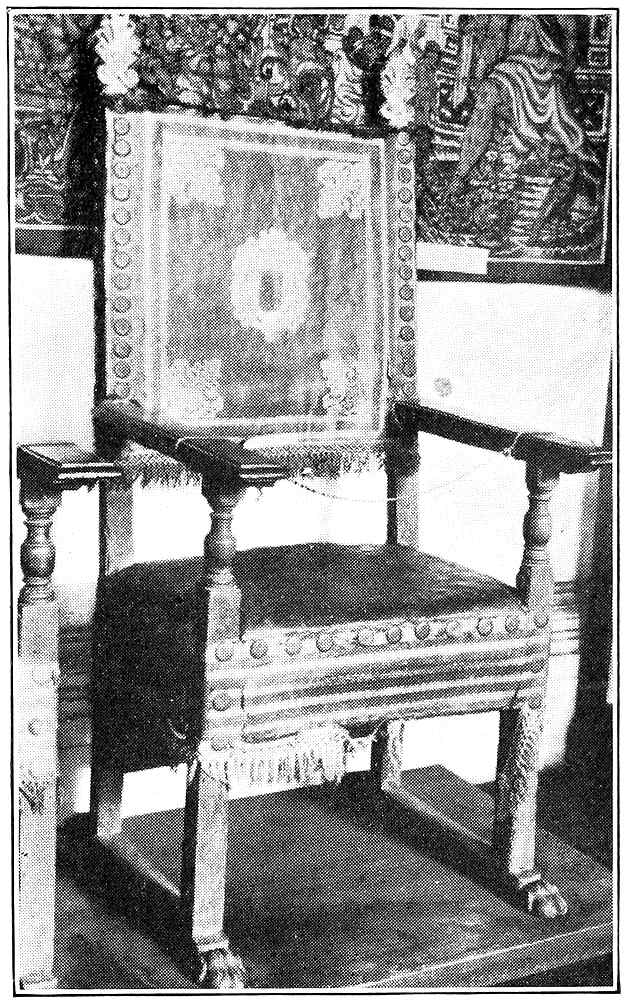
FIG. 2
The chair shown in Fig. 4 is an English ladder-back side chair from the seventeenth century. Here we have both comfort and practicability combined. The seat is built up with webbing, canvas and stuffing, and covered with a needlework tapestry. It is finished with a fringed gimp with brass headed nails.
[Pg 10]
Not only does upholstery add comfort to furniture, but it reflects the conditions in the life of a people. Alice F. Schmall said recently: “With the accession of James I to the throne of England the style of dress changed to trunk hose and padded doublet, and the carven forms of furniture gave place to upholstery. There is a sense of dignity and refinement about a really fine chair; and the modern upholstered chair, which Chippendale developed, shows that our ancestors were fully alive to its advantages in the way of comfort.”

FIG. 3
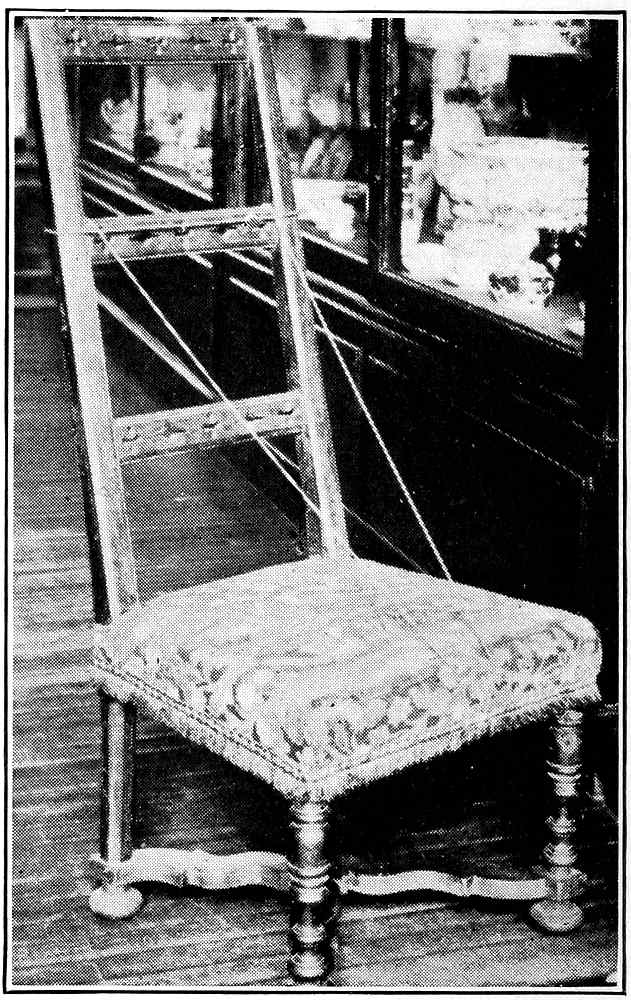
FIG. 4
Good modern upholstery is to a great extent a copy of the older forms. Newer goods are utilized but old methods of application are retained. The cheaper forms of upholstery are, however, entirely modern. While formerly there existed no cheap upholstery, today wire and band iron are used in place of webbing, and tufting is done by machine.
[Pg 11]
TOOLS.—The only tools needed in simple upholstery, besides those in the average manual training shop, are a gimp hammer, a webbing stretcher, a pair of scissors, a regulator and straight and curved needles. In Fig. 5, from left to right are illustrated: webbing stretcher, regulator, gimp hammer and a pair of scissors.
The webbing stretcher may be made by driving nails into a formed piece of wood as shown, 3½ inches wide by 7 inches long. Then cut or file off the heads and file each to a sharp point.
The regulator is a long wire sharpened at one end and used for sticking thru the muslin cover to rearrange the stuffing, to insure evenness. This tool may be made from a heavy wire bent in the form of a ring at one end, and sharpened at the other. Scissors 8 inches or more in length are more convenient than smaller ones.
Two needles are required, a straight double pointed one 12 inches long, and a curved single pointed one 6 inches long. Several other kinds will facilitate work, however. A straight, double pointed 6-inch needle is convenient for sewing springs to webbing and triangular pointed needles are best adapted for sewing leather.
Skewers are upholstery pins, usually 3 or 3½ inches long. They are pointed on one end and bent in a circle on the other. These are used in doing welt-edged work, or wherever it is necessary to hold goods temporarily while adjusting the work.
All these tools may be purchased from any firm dealing in upholstery supplies.
MATERIALS.—Webbing is our first consideration in the matter of materials. The two best kinds are L. M. C. and B. F. M. The former has a closer weave and is of better quality than the latter. It will withstand great strain before its elasticity gives out. It[Pg 12] is good policy to purchase the better grade inasmuch as it costs but 30 cents more for a 72-yard piece. L. M. C. comes in two widths, 3½ inch and 4½ inch, with the former width in more general use. The 3½ inch variety may be purchased for about $1.65 per 72-yard roll.
Burlap is the best material to use over webbing and over springs. It will not rip and tear as readily as most textiles and it is therefore a preferred material. Burlap comes in three weights: light (8 oz.), medium (10 oz.), and heavy (12 oz.). The medium weight is best adapted for our work. This may be purchased for 9 cents a yard. It is 40 inches wide. Used burlap may ordinarily be purchased at local dry-goods stores for about 5 cents per pound. Even considering waste, this is much cheaper and quite as good as new burlap for the work intended.

FIG. 5
Several kinds of material may be employed for stuffing. The very best material available is curled horse hair. It is also the most expensive, costing from 30 to 65 cents per pound depending upon quality. The stuffing recommended for such work as ours is tow. This may be purchased by the 100-pound bale at a cost of 2[Pg 13] cents per pound. There are three grades of tow: fine, medium and coarse. The fine variety should be used, for the coarser kinds are hard to manipulate and result in uneven surfaces after a period of use. Even with the medium grade of tow it is necessary to use a layer of wadding over it to prevent ridges showing thru the cover. Other stuffing materials are moss, kapok, alva, and excelsior. Cork shavings are generally used for boat cushions.
When cloth is desired between the stuffing and cover, unbleached muslin should be used. In cheaper work this is eliminated. In our work we will find it advantageous, for it gives to the seat the proper shape, and permits better and smoother work on the final covering. After the application of the muslin, if it is found that the seat is not of the desired shape, more stuffing may be added or the stuffing may be distributed by the regulator. Muslin 36 inches wide may be obtained for 7 cents a yard from any local dry-goods store.
Wadding is a kind of stuffing arranged in sheets. It is used over other stuffing. Its function is to give a smooth, even appearance to the seat or cushion. Wadding is invariably used over curled hair to prevent the ends of the hair from penetrating the cover. It may be purchased in sheets 30 × 36 inches; the one pound quality at 35 cents per dozen sheets.
It is generally desirable to place cloth under the seat to prevent dust from falling to the floor from the seat, and to exclude moths from the stuffing. Cambric is desirable for this purpose. It has a finish which makes it dust-proof, but it tears easily and cannot supplant the muslin used over stuffing. Cambric comes in a 24-inch width and costs about 5½ cents per yard.
There are innumerable varieties of fabrics adapted for outside coverings, and good taste and judgment must be used in selecting proper kinds for certain jobs. It is obvious that office and library furniture require coverings of a different quality and kind from that of the living room; and dining room furniture from that of the bedroom. A footstool may properly be given a covering of different character from a chair seat. In the selection of figured goods great[Pg 14] discretion is necessary. The figures on fabrics for a chair seat or back should manifestly be smaller and more subdued than those for a sofa or davenport. A sense of good design needs to be developed here, for proper selection is essential, both as regards color, figure, and adaptability to the particular structure, and its placement.
The first piece of tapestry woven in this country was completed in 1893. It was for a chair seat. The second was a counterpart of the first and is now in the Field Museum of Chicago.
Tapestry may be defined as printing in colored threads. The most perfect work in tapestry is produced on vertical looms, but one-third more work may be accomplished on horizontal looms in the same length of time. A Gobelin workman on a vertical loom produces on an average, one square yard of tapestry in 300 working days. The art in this work is the graduation of shades. In the best days of tapestry weaving, between 1450 and 1550, but twenty to sixty shades were known, while today we have knowledge of over 14,000.
“Brocade” is the term applied to any material having a raised pattern. Formerly the name referred to materials with embroidered patterns upon colored fabrics. “Chintz” is the term applied to cotton cloth printed with a floral or bird design. “Denim” is a strong, twilled cotton fabric. “Gunny” is jute-cloth. “Burlap” is a substitute for gunny cloth.
There are three classes of coverings in upholstery: genuine leather, textiles, and leather substitutes. Leather substitutes, or so-called artificial leather, is well adapted for beginners in upholstery, and is inexpensive. It is manufactured in 50 and 54-inch widths, and costs from 60 cents to $1.75 per yard. Trade names of leather substitute are Marokene, Chase Leather, Hercules, Victor Leather, Pantasote, Mole Skin, Mule Skin, etc. The better varieties are very durable and very closely resemble leather. Genuine leather costs from 16 to 36 cents per square foot in the whole hide or full skin, and up to 75 cents per foot cut to size. Cloth or textiles cost from $1.00 to $3.00 per yard in the general run of grades. They may cost as high as $10.00 per yard. Tapestry may run into prohibitive costs. Some of the best textiles are tapestries, brocades,[Pg 15] velvets, plushes, satins and hair cloth; cheaper ones are velours, chintz, reps, and denims.
Gimp is a narrow edging used for covering raw edges of the cover and heads of common tacks which secure the cover. It comes in rolls of 25 to 36 yards. Black imitation leather gimp costs 20 cents a roll of 25 yards, and brown or Spanish, 35 cents. Cloth gimp costs from 2 to 3 cents a yard.
Three kinds of nails may be used in the work outlined: solid leather, Perfection and Metalene. Metalene is perhaps the most satisfactory. These come in the following numbers with attendant sizes; No. 230—½-inch head; No. 240—⅜-inch head; No. 250—7/16-inch head; No. 260—9/16-inch head, and No. 270—¾-inch head. No. 250 is used in our work. They cost 80 cents per thousand in the plain, and 90 cents in Spanish effect.
Upholstery springs may be purchased from 3 to 16 inches in height. They cost 6 cents a pound and weigh from 22 to 100 pounds per gross. On this basis the cost of the large ones approximates 4 cents apiece. The 9-inch springs are most frequently used, and their cost is a trifle over 2 cents apiece. It is better to purchase springs longer than necessary than to obtain them too short, for they may easily be tied down. They should be twice as long as the width of the rails into which they are placed.
Spring twine is needed for tying the springs. No. 60 four-ply Italian hemp serves this purpose very well. This can be purchased for 27 cents a pound in one-pound balls.
Stitching twine is also needed for spring and stitched edge work. For this purpose No. 252 elm flax stitching is used. This costs 30 cents per half-pound ball.
The prices quoted are wholesale. Retail prices vary so much in different communities, and even in different places in the same community that they cannot be given with any fair degree of accuracy. The wholesale prices quoted will, however, give some idea of the cost of materials to the workman. At present, however, even wholesale prices are very unstable. All prices above are pre-war prices.
[Pg 16]
A LOW FOOTSTOOL.—This project is chosen for the first work in upholstery for the reason that it involves the simplest processes possible. Nailing a piece of leather or strips of leather across a frame cannot be dignified by the term upholstery. Therefore, such work is not to be considered under this head. The structure, in addition to the simple upholstery processes involved, requires but elementary bench work in wood in its construction.
After staining the stool take a small amount of tow, pull it out thoroly with the hands until all uneven bunches are eliminated; then spread it out evenly on the top of the stool as illustrated in Fig. 6. Then place a piece of muslin over this, tacking it with 4-oz. tacks ¼ inch from the edges of the board. The muslin should be folded over on itself at the edges, and stretched very taut. Tack each side first, then work toward corners. This method of tacking insures a smooth, taut surface, and should be followed always. Use the regulator, Fig. 7, to even out any irregularities and to force the tow well out toward the outer edges of the muslin. Then lay a piece of wadding over this to make a smooth surface; see Fig. 7. Next stretch a piece of Marokene leather of the color desired over the previous layers and secure it with 2½-oz. tacks. These should be placed about 2 inches apart, ¼ inch from the edges of the stool, and surplus fabric trimmed to ⅛ inch from edges. Finally, cut a piece of gimp and secure with Metalene nails as shown in Fig. 8. Fold the gimp at the corners and splice at the last corner. Place the nails equal distances apart on parallel edges.[Pg 17] Be sure that the leather, gimp and nails harmonize with each other and these with the final color of the stool.
A CART.—The different processes for upholstering a cart, illustrated in Fig. 9, are identical to those just described, with the exception that a margin is left at the edges of the seat. The cart suggests a very practical application of simple upholstery, either in covering a wood seat or in replacing a worn upholstered seat.

FIG. 6
A LEG REST.—The processes of upholstering the leg rest shown in Fig. 10 vary substantially from those already discussed. Here is the first introduction to a hard edge. Reference to Fig. 10 will show how this edge is made. Chamfer the upper arris of the seat as wide as the tack head and drive the tacks in at right angles to the chamfer. This method avoids splitting the corners. The near side of the illustration shows a piece of burlap tacked with two-thirds of its width overhanging. Use 4-oz. tacks for this purpose, and tack in such a way that the heads of the tacks are even with the edge of the seat.
After the burlap has been secured in this way insert a small roll[Pg 18] of tow or a strand or two of welt cord under the burlap at the edge of the seat. The diameter of this roll may vary from ¼ to ½ inch as desired. Bring the burlap over and around the firmly packed tow or cord, and tack down extremely close to the roll, keeping the roll round. Special effort should be made to keep the roll smooth and even, for its form determines the final form. The rear side of the illustration, Fig. 10, shows the completed roll.

FIG. 7
Strips of webbing may be employed in place of burlap. Webbing is a closer woven fabric than burlap, and in consequence produces a more even roll. And webbing cord is preferable to tow for it requires less time to place and results in a smooth edging.
The strip of soft wood shown in the illustration is called an upholstery block. Gimp and muslin are secured to this block. Without these blocks, one at each end, the cover could not be placed without much labor and resulting unsightly folds at the corners.
After the corner strips are placed and the rolls formed, place[Pg 19] sufficient tow on the seat to produce a slightly rounded top when the tow is pressed down firmly with the hands. The tow must be picked, that is, pulled out thoroly to make it even and fluffy. Place over this a piece of muslin, tacking it temporarily at the center of each side with several 2½-oz. tacks. These should be only partly driven, a process called slip-tacking or loose-tacking. Stretch it tightly, and bring the threads of the muslin in line with the edges of the seat. Next pull out the tacks from one side and re-stretch the muslin by stroking it several times with the left hand, always holding it with the right. Do this on each side in succession. An expert workman will hold the tacks in his mouth and the hammer in the right hand during the whole process. After the muslin has been placed use the regulator and re-distribute the tow should any unevenness exist. This process is called regulating.

FIG. 8
[Pg 20]

FIG. 9
Next place the cover. Whether it be genuine leather, leather substitute or textile fabric, proceed as with the muslin omitting folding the edges. Stretch the cover tightly and tack with 2½-oz. tacks. Place the tacks a small fraction of an inch from the lower edge of the board so the trimming of the cover may be easily done. Apply the gimp. This covers the raw edges of the materials and tack heads. Start at the right-hand corner, fastening it with a 2½-oz. tack. Carry it across to the left-hand corner and fasten with another tack. Fold it upon itself so as to form a definite crease then twist it over and carry it up and along the soft wood strip to the next corner. Repeat this process to the starting point; then cut the gimp off flush with the bottom of the board and secure with a tack. As the forty-five degree folds are made, the gimp nails should also be driven in place. Fig. 11 shows the steps in making the folds at the corners. Space distances equally and place all gimp nails. A desirable distance is from 1½ to 2½ inches—depending on the cover material. A quick way to place[Pg 21] these nails is to drive a nail in the middle of an edge, then one in the half way points between this and each corner, and so on. This process gives good eye training. Fig. 12 shows completed leg rest.

FIG. 10
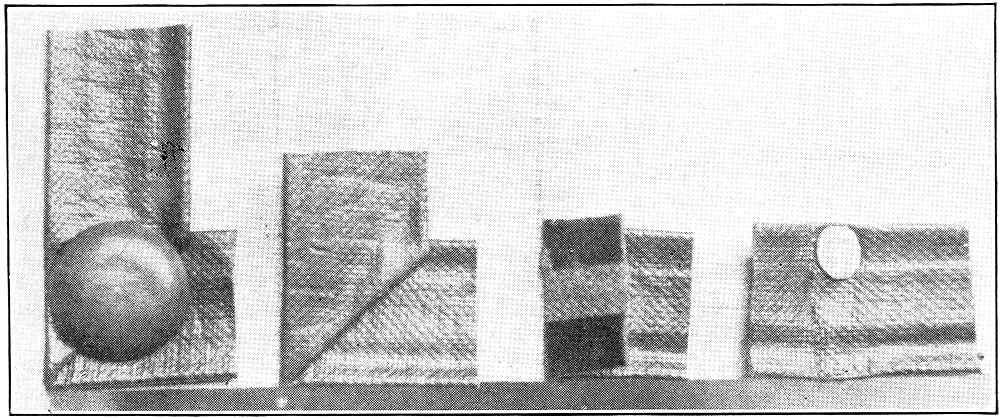
FIG. 11
A FOOTSTOOL.—The upholstery operations on the stool shown in Fig. 13 are very similar to those on the leg rest. The rolls are formed identically but are placed on four sides. Special care must be exercised to keep the corners firm and even, and in line with other parts of the rolls. The cover needs folding at the[Pg 22] corners to make it smooth. The gimp runs continuously around the edge without folds. This form of stool requires a greater amount of upholstery material than the first form, and is not as pleasing in structural design, but is a more comfortable structure.
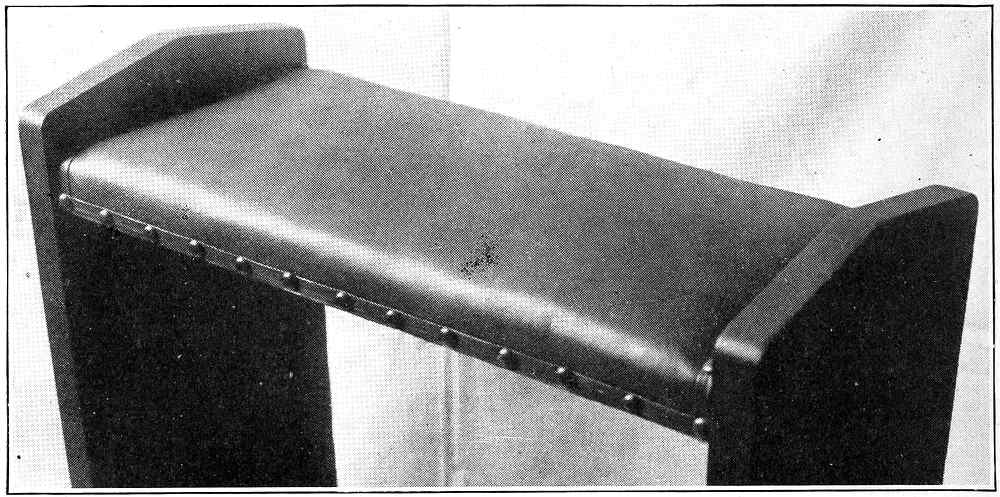
FIG. 12
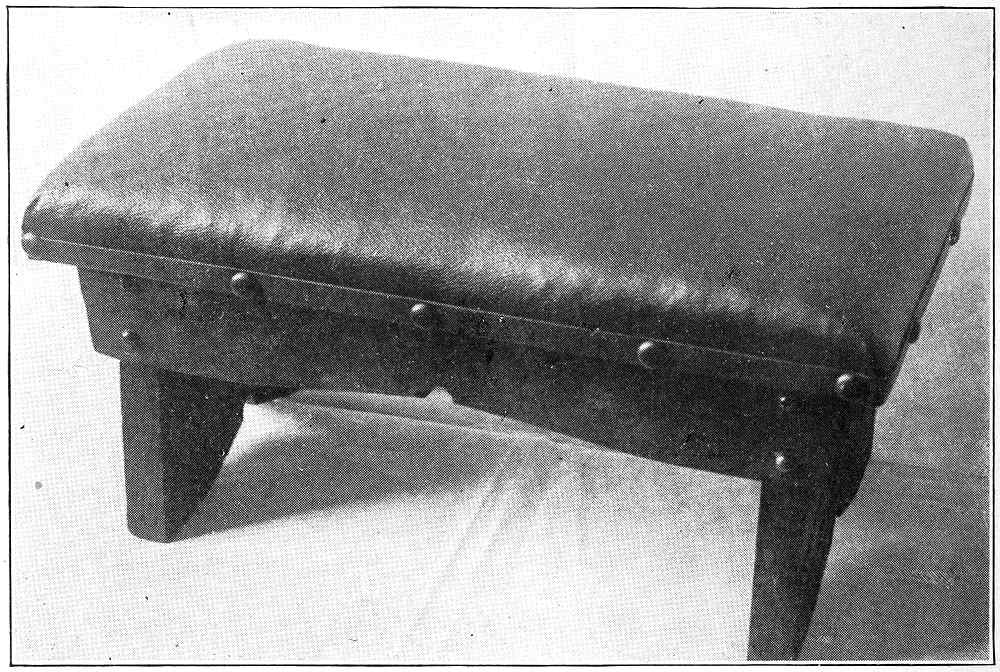
FIG. 13
[Pg 23]
MATERIALS REQUIRED.—This stool, with top 9×14 inches requires the following materials for upholstering:
| Quantity | Material | Size |
| 2 pieces | Burlap | 3×14½ inches |
| 2 pieces | Burlap | 3×8 inches |
| 70 | Tacks | 4 ounce |
| 10 ounces | Tow | |
| 1 piece | Muslin | 11×18 inches |
| 60 | Tacks | 2½ ounce (For muslin and cover) |
| 1 piece | Marokene | 12×17 inches |
| 46 inches | Gimp | |
| 14 | Metalene Nails |
[Pg 24]
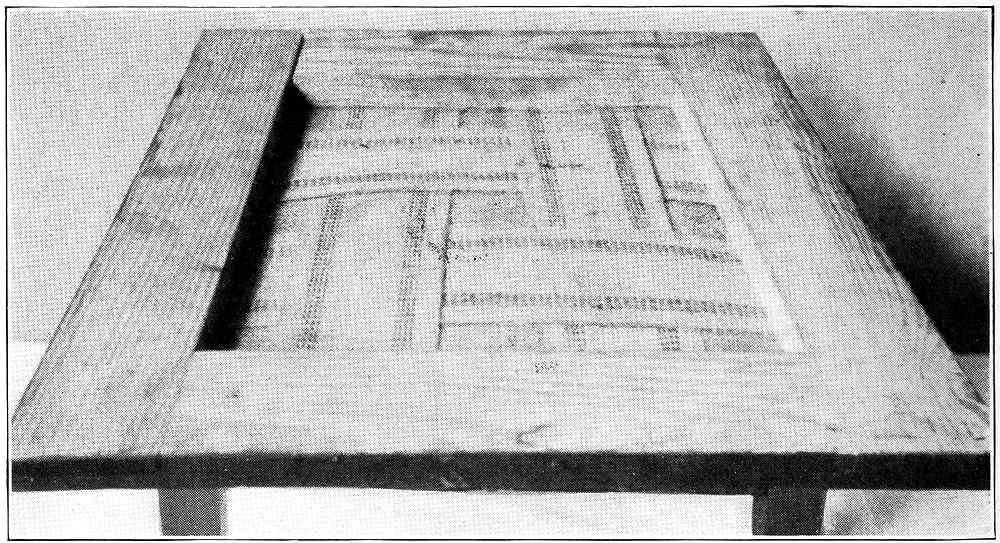
FIG. 14
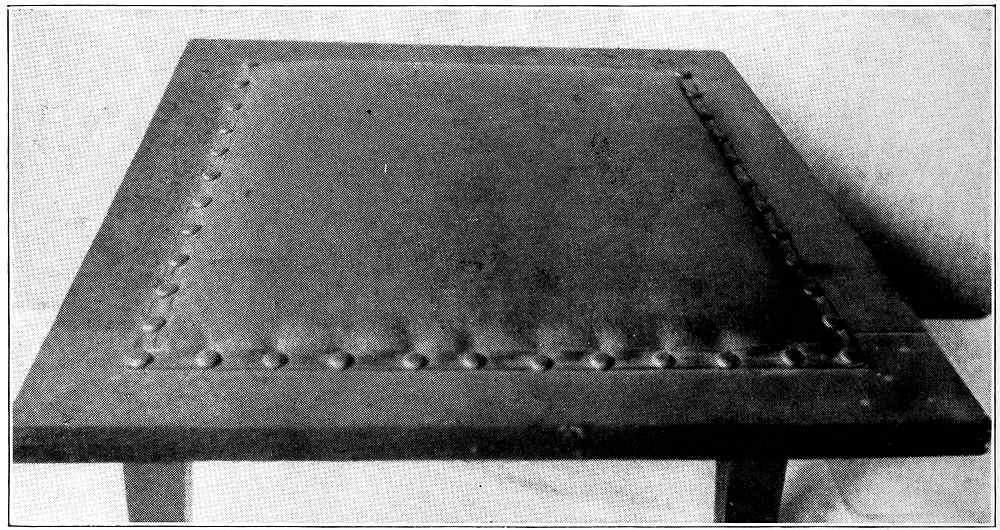
FIG. 15
A CHAIR SEAT.—The typical upholstered seat is undoubtedly that of the dining chair. The processes involved are very simple.[Pg 25] A shallow rabbet should be run along the inside edges of the seat frame, say about ⅛ inch deep and ¾ inch wide. This will permit the gimp to run flush with the top of the seat frame when all work is completed.

FIG. 16
First decide on the number of lengths of webbing that will be required for the given area. Then, using the best of webbing, take one end and tack with 10-oz. tacks. If hard wood is used in the structure and it tends to split, use smaller tacks, say 8-oz. or 6-oz. Stretch the strand of webbing with the webbing stretcher, and tack as illustrated in Fig. 23.
When four tacks have been driven in cut the webbing off 1 inch beyond the row of tacks; fold over, and tack down with three tacks placed between the four previous ones. Folding the ends over rather than under is better practice, for the fold protects the webbing at the points of greatest strain. Use as many tacks as the wood will permit, for many tacks distribute the strain over all threads of the webbing. After the lengths of webbing have been attached from front to back weave lengths thru these from side to side as shown in Fig. 14, and secure in the same manner. The illustration shows the underside of the seat.
Next tack burlap over the webbing with 4-oz. tacks. Cut the burlap slightly larger than the opening, including the rabbet, and fold the edges over in tacking. Stretch the burlap slightly to prevent sagging in the opening, but not so tight that the webbing will not support practically all the weight.
[Pg 26]
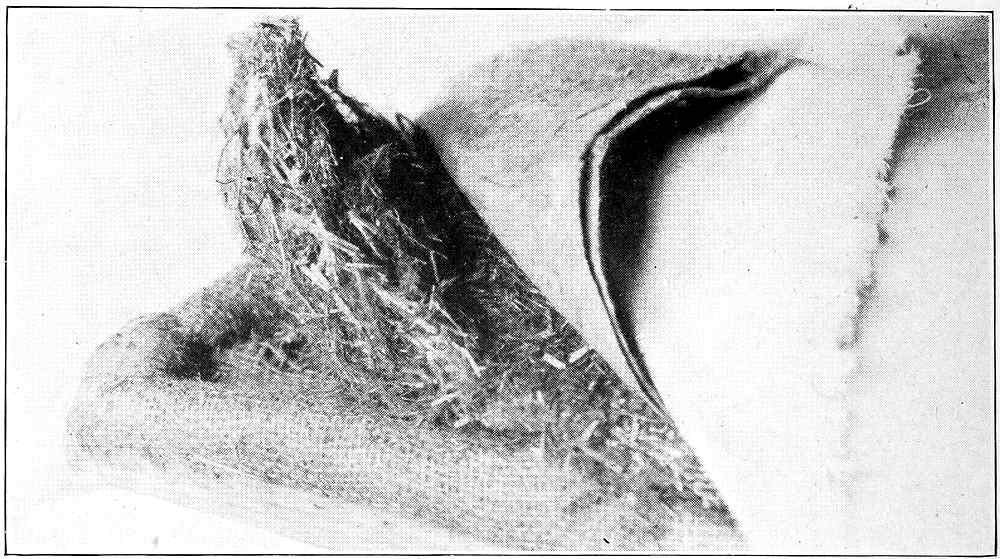
FIG. 17
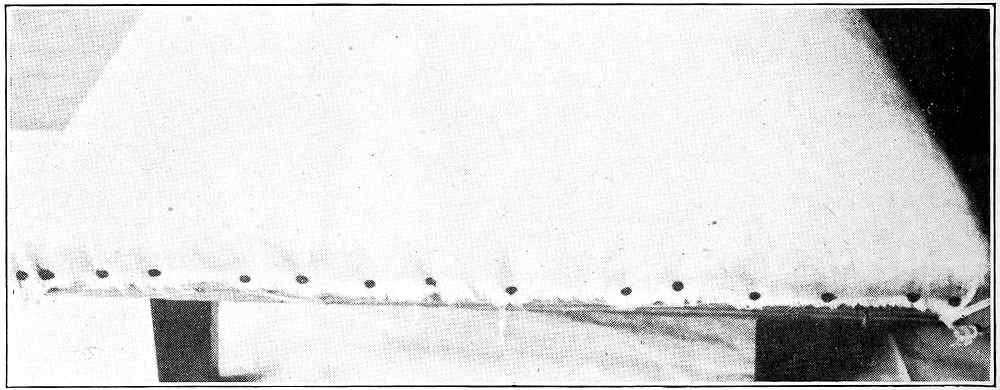
FIG. 18
Now place the stuffing, tow, picking it and working it into shape. Over this secure muslin and then lay a sheet or two of blue-sheet wadding over all. Place the leather substitute, and the gimp and nails. The gimp is nailed against the rabbet edge, Fig. 15. These processes have been described and need no repetition here. The finished seat frame is shown on a dining chair in Fig. 16. The back of the chair is also upholstered, practically in a manner identical to the seat. On the rear of this back a piece of leather substitute[Pg 27] of same color and finish as the front is tacked and the edges covered with gimp. It is a good practice to tack a piece of cambric under the seat frame for sanitary reasons indicated in a previous chapter.

FIG. 19
A SET-IN SEAT.—This form of seat is very convenient for any chair or stool where a set-in seat is desired. Cleats on which the seat rests may be screwed or nailed to the rails, or the rails may be rabbetted to receive them. Corner blocks may also be utilized for the purpose. In addition the seat may be fastened to these rests with screws. This usually prevents the chair from squeaking, due to a loose seat.
In constructing the wood frame for this kind of seat allow at least 3/16 inch for the thickness of materials. More allowance should be made for thick material and genuine leather.
Attach webbing and burlap in the usual manner; then form the hard edge as described previously. The hard edge is shown in Fig. 17 together with tow, wadding, and muslin, and Fig. 18 shows the seat ready for the covering after the trimming of the raw edges. The finished seat placed in a rocker is illustrated in Fig. 19.
[Pg 28]
FOOTSTOOL.—A stool which makes a very interesting problem for simple upholstery is shown in Fig. 20. This is typical of that class of structures on which the coverings completely hide the rails, leaving only the legs exposed. The rails should be placed ⅜ inch below the rounded part of the legs, and be at least ⅞ inch thick. Inside arrises of the rails should be rounded with a rasp to prevent the webbing from eventually being cut thru. The framework of such a structure is shown in Fig. 21. Attach the corner blocks as shown in Fig. 22; then properly stretch the webbing and tack it in place. The webbing is the ground work of upholstering, and the durability of the work depends to a considerable degree upon its quality and proper application. Use the original roll of webbing. This enables the worker to use the webbing stretcher without waste. Both ends should be used. This permits the utilization of the two free ends, and allows freer work. Fig. 23 illustrates the method of using the webbing stretcher.

FIG. 20
[Pg 29]
PROCEDURE.—Fold the end of the webbing over about 1 inch and tack with five 10-oz. tacks as near the middle of the rail as possible. This is illustrated in Fig. 24. The ends of the webbing should be folded over and not under, as suggested before. The tacks will hold better. The middle length of webbing should be placed first to facilitate equal spacing between strands. The other free end of the bolt of webbing should be tacked on the opposite side in like manner to assure proper spacing. Fig. 24 shows the ends tacked and stretched from the same side, but in tacking them from the opposite sides it tends to prevent splitting, for the last ends are to be secured with seven tacks. After the first end is secured with five tacks use the webbing stretcher and pull the webbing across, extremely taut, and fasten with four tacks while thus stretched. Do likewise with the second strand. Cut each piece about an inch from the tacks; then fold over and tack with three tacks. Before tacking the two long strands they should be woven thru the shorter strands as illustrated in Fig. 24. The openings between strands should not exceed 2 inches.

FIG. 21
[Pg 30]
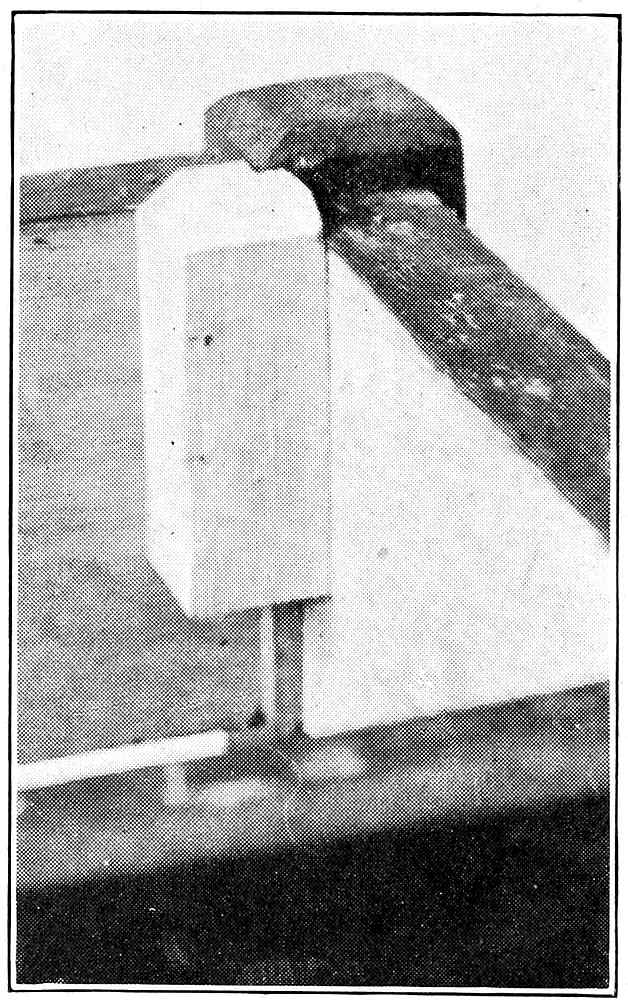
FIG. 22
Cover the webbing with burlap. The edges of this should project slightly beyond the ends of the webbing, as illustrated in Fig. 25.
It is desirable, in fact essential, in all upholstery to keep the cover away from the wood as much as possible. This prevents the cover from becoming worn or cut, and avoids a hard, uncomfortable edge for the occupant of the upholstered structure.

FIG. 23
[Pg 31]
A simple expedient to avoid this contact with wood is to attach a hard edge all around the top of the rail. This edge is made by tacking strips of burlap on in such a manner that tow may be rolled in them. They are then retacked behind the roll. The first row of tacks should be placed so that the heads run flush with the outer edge of the rail. The strip of burlap on the farther side of the stool shown in Fig. 26 is fastened in this way. The roll on the near side is complete. On the left end the burlap is shown partly rolled back to reveal the tow in place. The tow must be thoroly worked in with the finger to produce an even, smooth edge, and the burlap drawn tight to make it firm.

FIG. 24
Fig. 27 shows all four rolls in place ready for the corner or upholstery blocks, providing the first form of corner blocks illustrated in Fig. 22 have not been attached. The first form of block is preferred by most workmen. In Fig. 26 is shown the second form of[Pg 32] corner block in place. This is fitted behind the rolls, and is cut in a manner to avoid short grain, which has a tendency to split. Corner blocks are required when gimp is run continuous around the edge of the cover. These are secured with several brads, against both posts and rails. Take tow and pick it over thoroly; then place it upon the stool making a rounded heap from the top edges of the rolls. Pack and work into place very thoroly to secure an even seat. The hands easily detect uneven areas, and may be more readily depended upon than the eyes.

FIG. 25
[Pg 33]
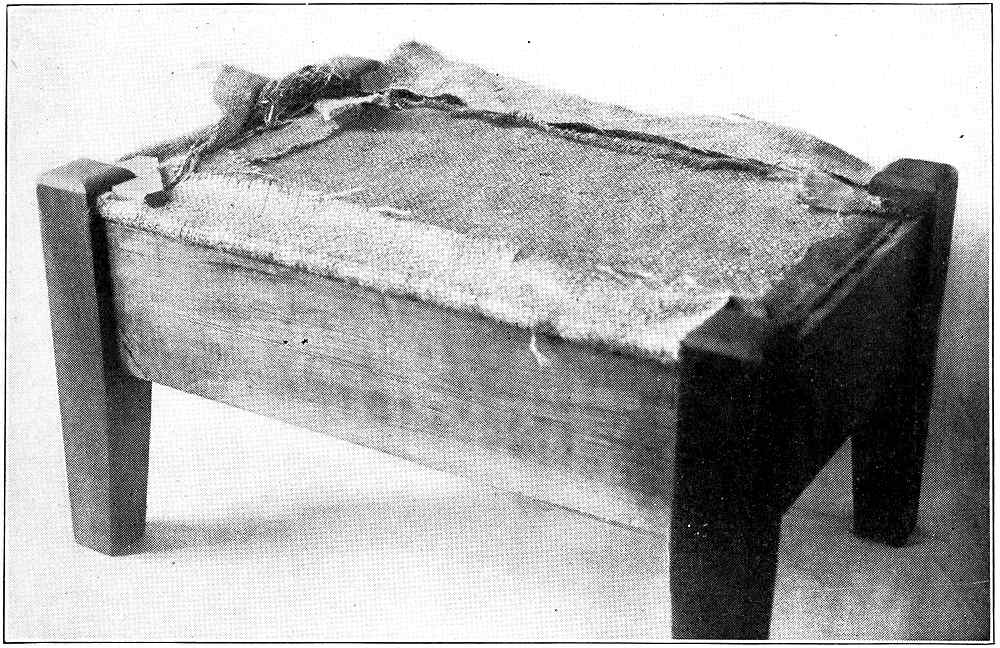
FIG. 26
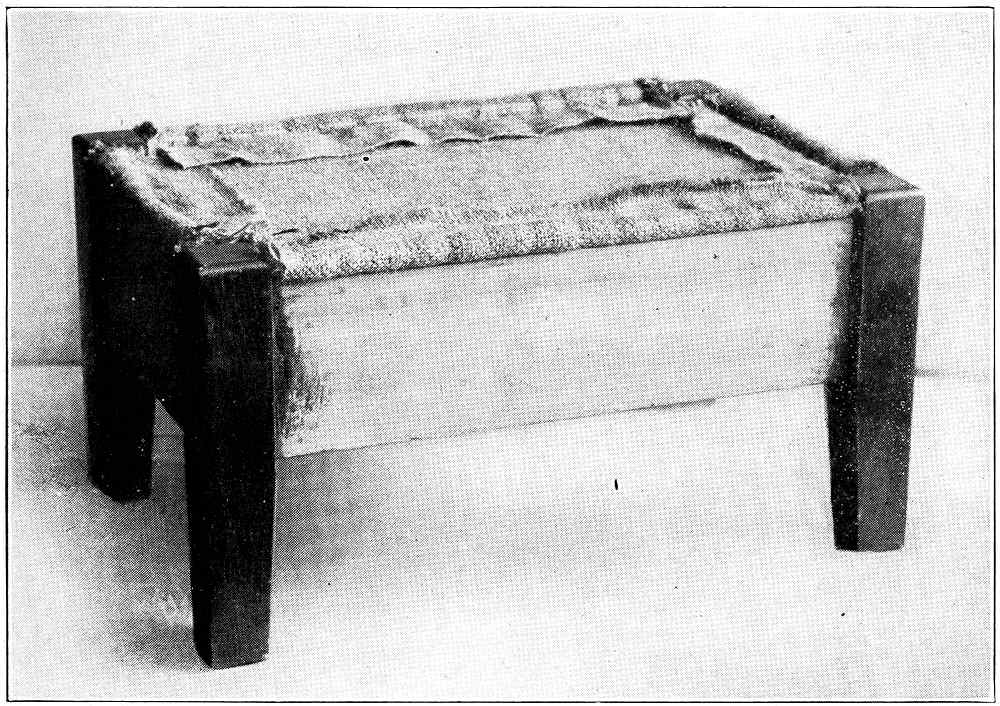
FIG. 27
[Pg 34]
Now stretch and tack the muslin in place. Fig. 28 shows the processes completed. Slip-tack it in the centers of four sides with two or three tacks to a side. Slit the muslin diagonally from the corners to a point immediately inside the legs. Fold the edges under; work from the center toward the corners, and tack the muslin permanently. Keep the muslin smooth and drawn tightly.

FIG. 28
The covering is placed practically in the same manner as the muslin. Great care must be exercised to avoid cutting too far at the corners, to have the material fit snugly, and to have the whole job firm and smooth. If, after the gimp has been placed, portions of the covering show below, these may be trimmed easily with a sharp knife or chisel.
[Pg 35]
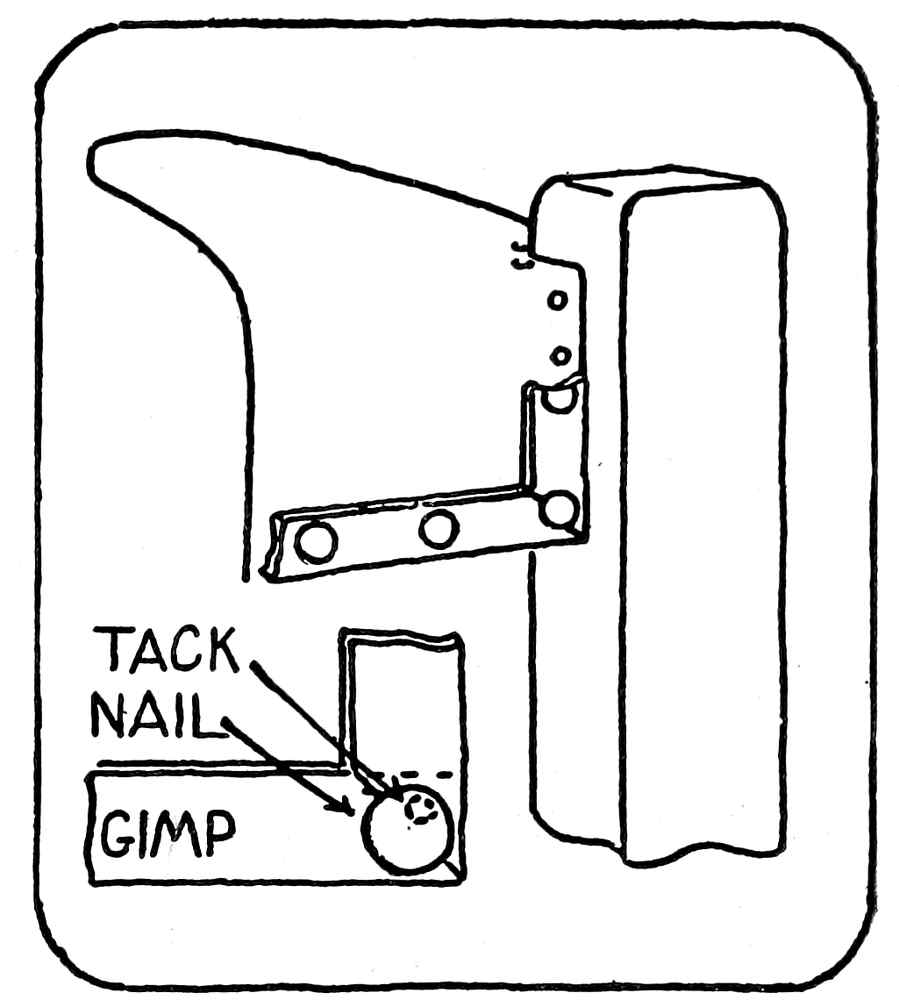
FIG. 29
The method of fastening gimp has been explained. Fig. 29 illustrates the scheme of tacking, folding and nailing. In Fig. 30 are shown different treatments in the placing of gimp. The right-hand stool requires no roll, inasmuch as the gimp is fastened on the top of the rails.
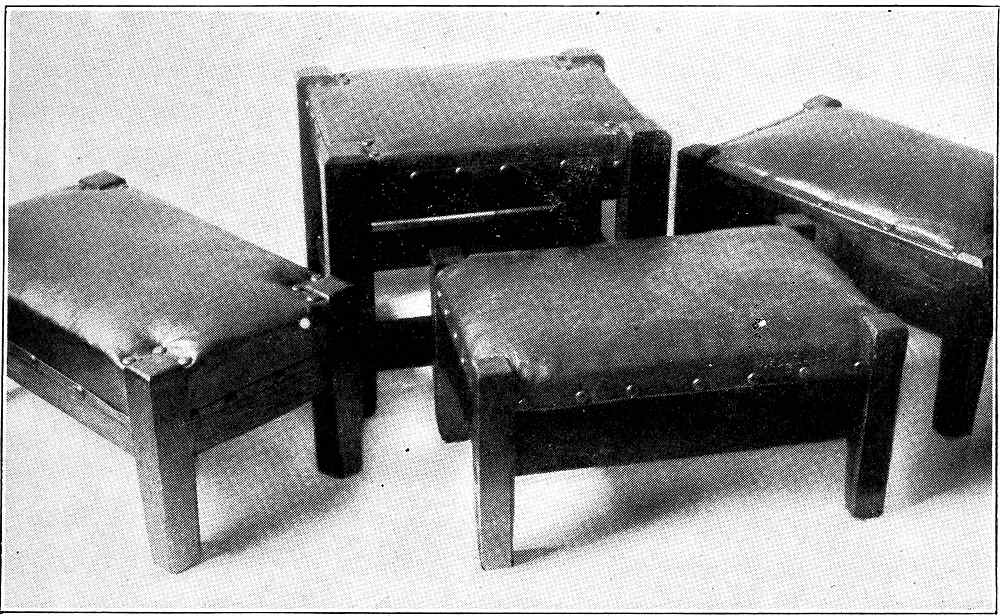
FIG. 30
[Pg 36]
MATERIALS.—The following materials are required for upholstering a stool such as illustrated in Fig. 20:
| Quantity | Material | Size |
| 2 yards | Webbing | L. M. C. 3½ inches |
| 5 dozen | Tacks | 10 ounces. |
| 1 piece | Burlap | 12×18 inches |
| 2 pieces | Burlap | 3×8 inches |
| 2 pieces | Burlap | 3×13 inches |
| ¾ pounds | Tow, fine | |
| 1 piece | Muslin | 14×20 inches |
| 1 piece | Wadding | 10×16 inches |
| 1 piece | Marokene | 19×25 inches |
| 1 piece | Gimp | 2½ yards |
| 5 dozen | Metalene Nails |

FIG. 31
[Pg 37]
ORDER OF PROCEDURE.—The following order of processes in upholstering may be considered standard:
DIFFERENT METHODS.—This type of footstool may be treated in a variety of ways. Webbing may be omitted as a base for the upholstery and a board substituted, preferably some thin stock. Instead of bringing the cover down to the lower edge of the rails as in Fig. 20, a shallow rabbet may be run and the upholstery brought to the edge of this as shown in Fig. 31. Or it may be treated in the manner shown on the footstool illustrated in Fig. 30. In this instance it would be similar to a pad seat. The rails of the stool should here be placed even with the chamfer on the legs. The stool may also be upholstered with a welt edge. This method is very desirable when the worker is limited to small pieces of tapestry or leather. Welt-edged work will be described in a chapter on spring-edge work.
[Pg 38]
The hard-edge seat as it is technically termed is relatively simple when compared with other kinds of upholstering, but it is probably the most important of the group. The edge of the seat needs to be stuffed and sewed in a manner that makes it hard and firm, while the center is springy. With a working knowledge of this class of upholstery one may make some of the finest pieces of furniture without difficulty. The directions to be given may be modified to suit any particular piece of work in this group.
METHOD.—Construct a frame 18 × 24 inches outside dimensions, and 3 inches deep. Employ a simple butt joint, secured with nails and reinforced with corner blocks as shown in Fig. 32. A light, close-grained wood, as poplar, basswood or pine is preferred to hard, open-grained wood.
The webbing is fastened in place as described in Chapter V, using but three strands crosswise and two the lengthwise of the frame. This is a different type of work, and the suggestions as to spacing do not apply here as in the footstool just described. The webbing is placed so that the springs, six in number, stand over the laps. A distance of about 3 inches should be left between the outer edge of the frame and the springs. The webbing is 3½ inches wide, and the No. 3 springs used are 5 inches across. These dimensions determine that the strands of webbing should be 3¾ inches from the outer edge of the frame.
Place springs in position turning the bent ends up. Sew these to the webbing with stitching twine using a 6 or 12 inch double-pointed[Pg 39] needle. Make at least three loops around the bottom coil, fastening it securely to the webbing. Pull the twine taut and tie the final end to a nearby stitch. Fig. 33 illustrates the method of sewing.

FIG. 32
Next the springs are tied with spring twine to keep them in an upright position, and to prevent breaking down and bending. The twine also supports the burlap and stuffing above it. After the springs are tied down the twine should receive all the pull from the reaction. Upon the permanency of the webbing and spring twine depend the lasting qualities of the seat. The twine generally deteriorates or breaks first, and then the webbing. To insure a relatively permanent seat tie the springs eight times, that is, place four strands across each spring, one from front to back, one from[Pg 40] side to side, and two diagonals. Multiply the dimension of the frame by one and two-thirds to determine the lengths of twine required.

FIG. 33

FIG. 34
THE PROCESS.—Tie a simple knot in one end of a length of twine. Drive a 10-oz. tack thru this into the top edge of the frame and in line with the centre of the spring. Then stretch the twine across the top of the springs to the opposite side of the frame; pull the springs down with it until the outer side of the coil is about 6 inches from the bottom and the inner side about 7 inches. Adjust the springs to stand vertical. Grasp the twine and spring nearest the fastened end with the thumb and forefinger of the left hand; hold them, while with the right hand pass the free end of the twine down inside the coil, up on the left hand side of the fastened end, down inside the coil again, up on the right hand side of the fastened end, and thru loop thus formed. Pull it tight.[Pg 41] This is called a clove hitch knot. Its advantage is that it does not loosen even after the twine over the top of the wire wears off. With the easier knot the entire twine loosens immediately after the top wears. A careful examination of Fig. 34, and a little practice will clarify the method just described. Pull the twine taut to the other side of the coil and form another knot. This time, however, the twine is passed down on the outside of the coil first and up on the inside. Before tying the second spring space it at the top a distance equal to that at the bottom. When the second end is to be tied, drive a tack part way into the edge of the frame and wind the twine once and a quarter around it, pull it tight enough to bring the springs down properly, and drive tack securely. Drive a second tack close to the one at the end. The twine should be[Pg 42] fastened in just this way so that in moving up and down with the springs it will not wear away against the head of the tack.

FIG. 35
All other twines are fastened and tied in practically the same manner. However, care must be exercised that the springs are not drawn down lower with successive strands of twine, or an uneven strain and wear will result. The last twine should be tied to all others crossing at the spring centers, to prevent twine wearing at these points. A study of Fig. 34 should make clear any doubtful point.
Tack a piece of 10 or 12-oz. burlap on the top edge of the frame with 4-oz. tacks, folding the edges over as they are being tacked. Fasten it just tight enough to insure smoothness, avoiding pulling the springs down lower. As previously stated all spring reaction strain should fall on the twine exclusively. Sew the burlap to the springs with a curved needle and stitching twine. This keeps the burlap in position, prevents wearing, and helps to unify the seat.
[Pg 43]
Place the stuffing. Work over about 5 pounds of tow, and work it down and out over the seat until it extends about 3 inches beyond the frame as shown to the left of Fig. 35. Be careful to keep the tow even at all times, especially at the edges.

FIG. 36
Place a piece of light burlap, 6 or 8-oz. weight over the tow. It should be large enough to be slip-tacked on the sides of the frame. Stitch thru the two layers of burlap and the tow with a 12-inch double-pointed needle. The row of stitching should come just outside the edge of the springs. Each stitch should be about 3 inches long, and it is formed by passing the needle up and down thru the burlap. After all four sides have been stitched pull the twine tight. Begin at the first stitch and pull each taut in succession. Finally take a few stitches thru the center of the seat at irregular intervals, thus making the seat firm and compact. Do not stitch around the loose coils of the springs.
[Pg 44]
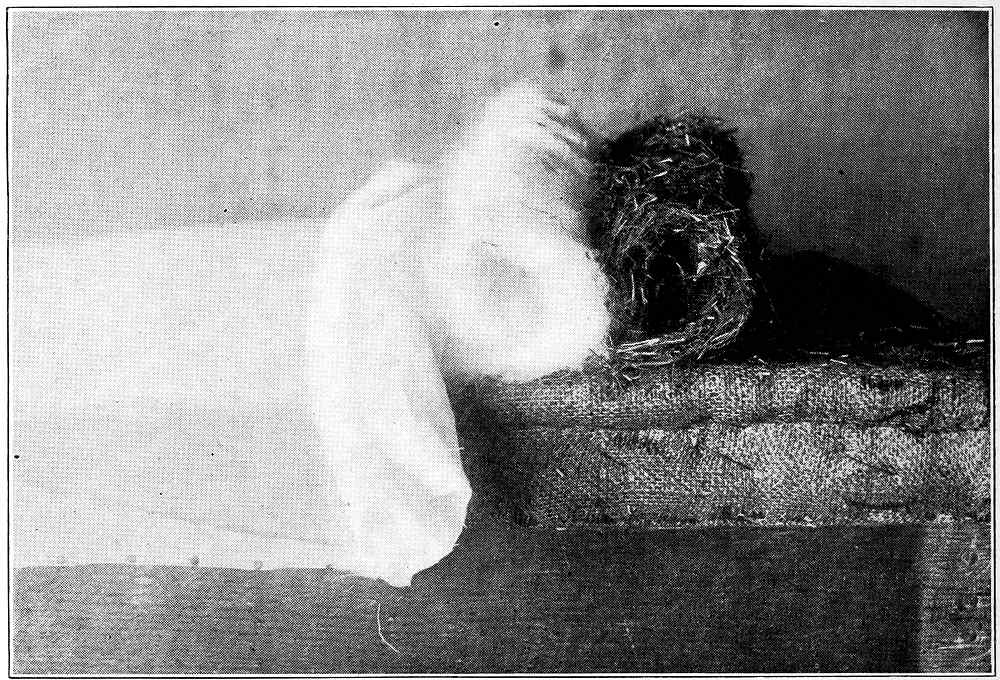
FIG. 37
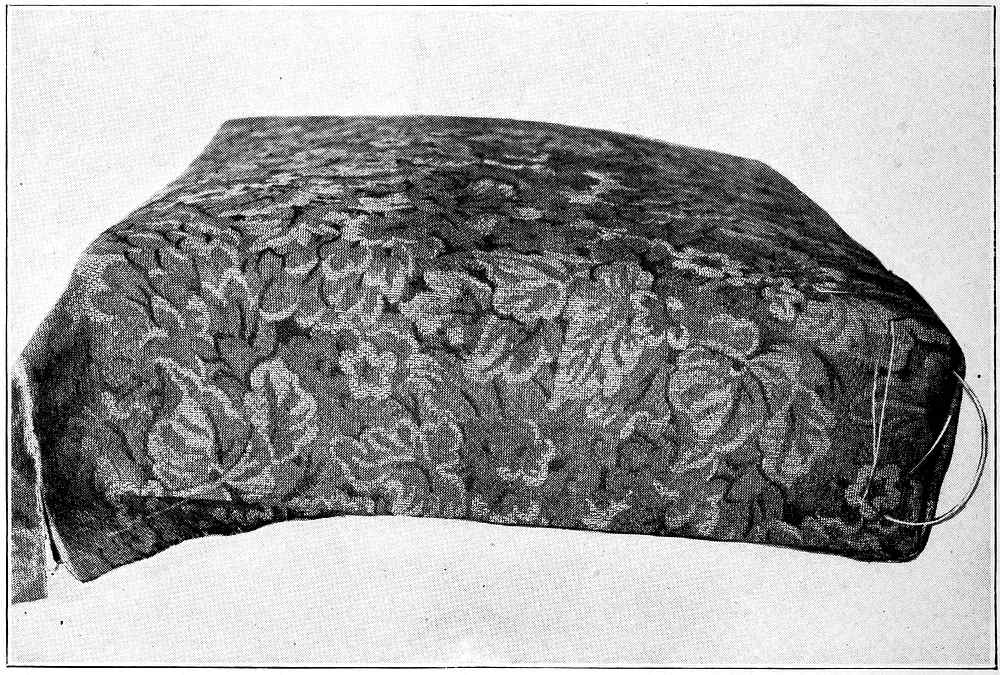
FIG. 38
[Pg 45]
Now release the slip tacking and roll the loose edges of the burlap under the tow. Drive tacks thru that part of the burlap which comes in contact with the top edge of the frame, beginning at the center of each of the four sides and working toward the corners. Use precaution to make all sides equal. Tack the corners last. Should they be too full, due to the overlapping of the burlap, cut away some burlap and remove the necessary amount of tow to keep the corner even with the sides.
We now arrive at that process in the development of the seat from which this class of upholstery derives its name. The stitching of the rolled edge already formed is rather difficult, and care must be exercised to assure a neat appearing seat. Stitch the edge around to the number of two or three rows. Use a 6-inch curved needle, and beginning at the left-hand end of one of the rolls, start the needle about 1½ inches from the row of tacks, and allow it to emerge about 1½ inches from the row of stitching. About 1½ inches to the right insert the needle into the roll again about ¾ inch from the row of stitching, and allow it to emerge about ¾ inch from the row of tacks. Tie the end of the twine around the other with a double slip knot. Insert the needle again about 1½ inches to the right, up thru the roll, and down as before. Repeat this operation around the four sides of the seat, regulating as the stitching progresses. The right-hand needle in Fig. 36 shows the first row of stitching. Always insert the needle at a right angle to the roll, for the arc of the needle gathers in considerable tow which is forced into the roll as the twine is pulled taut.
The second row of stitching is also illustrated in Fig. 36. The stitches in this operation are not made in a zig-zag manner as in the first row. The needle is inserted about ½ inch above the first row of stitching and allowed to emerge at the same distance on top. Work to the left at an interval of ¾ inch and use the double slip knot as previously. Pass the needle to the right about 2½ inches and insert it as at first, then carry it back again about ¾ inch and push it thru the roll allowing the end to project; then loop the twine[Pg 46] around the point. See left-hand needle in Fig. 36. Repeat on all four sides. After the second row of stitching is completed a third row of stitching may be made. Then place more stuffing on the top of the seat, rounding out all irregularities. This is called double stuffing, and work of this kind is termed double stuffed work. Hair is extremely resilient, and used for this purpose adds life to the seat. Moss will answer the purpose. Place a layer of cotton batting over this. Then a piece of muslin is finally tacked over all. Fig. 37 shows the muslin partly tacked, and the two layers of material rolled back. Keep the muslin smooth, especially at the corners, cutting away all surplus material.

FIG. 39
Use a cover of soft material rather than one of leather or substitutes. Secure it in place like the muslin, only tack it under the lower edges of the frame and fold it carefully at the corners as illustrated in Fig. 38. The process of blind stitching is plainly shown. When the seat has been covered tack a piece of cambric underneath. The hard-edge seat is then finished. Fig. 39 shows the completed cricket.
[Pg 47]
Figs. 40 and 41 illustrate double stuffed hard-edge seats utilized in chairs. The rocker in its entirety is the product of a young woman, a student in the author’s class.
A QUEEN ANNE STOOL.—This stool also has a hard-edge seat but the method followed is a modification of the one just described. In the former the upholstered seat was built over a box or frame, and fitted snugly into the cricket base. In this project the upholstery is fastened permanently to the rails; it becomes an integral part of the structure. The edge is blind stitched. The webbing cannot be tacked directly to the rails; they are too weak to withstand the strain, and in this instance are curved or formed, which precludes tacking webbing underneath. In such instances the webbing is folded several times and tacked thru the folds against the inner sides of the rail. If the rails are not sufficiently strong strips may be screwed on as reinforcement. This has been done in this instance as shown in Fig. 42. Frequently on such structures a brace or two is placed across between the long rails.
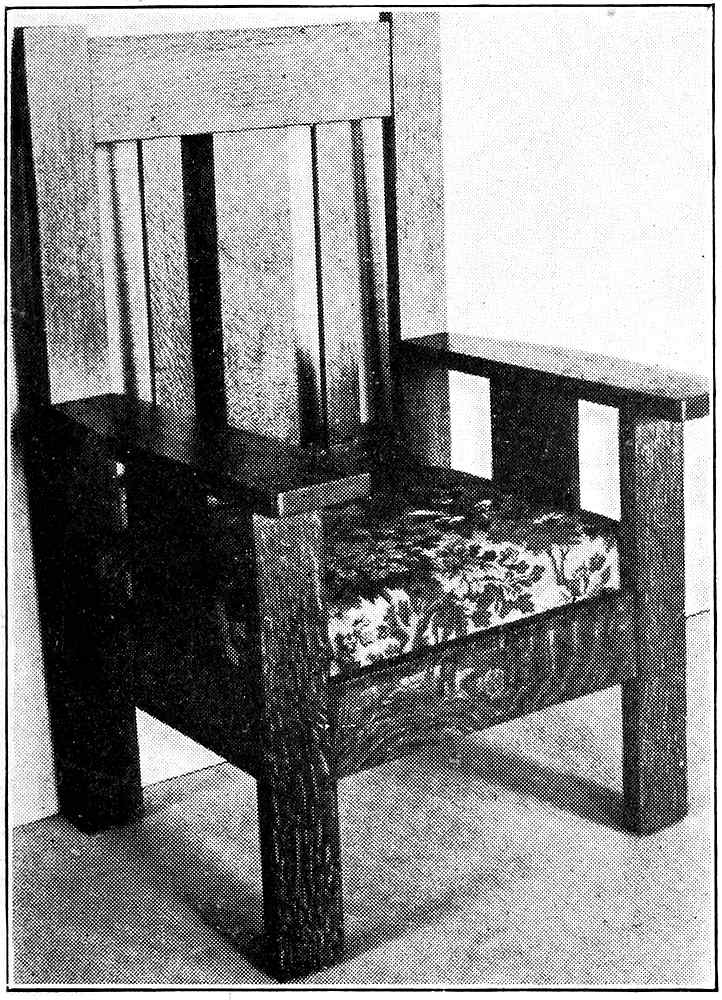
FIG. 40
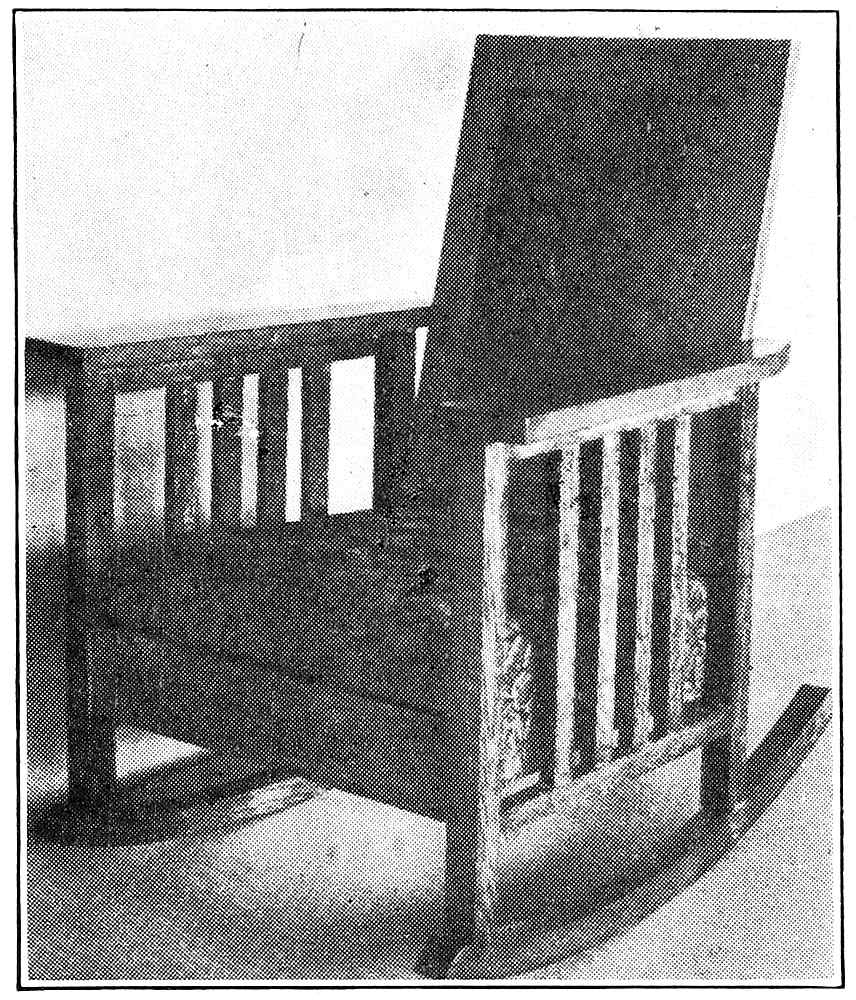
FIG. 41
[Pg 48]
The identical method of upholstering is followed from this point on as in the cricket, up to the point of stuffing. This seat is shallow requiring considerably less tow. Place just a sufficient amount to prevent the springs from being felt under pressure from the hand; then place and secure the burlap in the usual manner.

FIG. 42
Next sew the hard edge with a 12-inch straight double-pointed needle. Begin about ¾ inch above the rail, and permit the needle to emerge above about 4 inches from the edge. The left-hand needle in Fig. 43 shows the method. Pull the needle up to its eye as shown in the middle needle; then bend the point toward the lower edge. As it emerges toward the right loop the twine around the needle and pull it thru. This brings the twine around the tow, pulls it down firmly toward the lower edge and holds it there. This operation is frequently called blind hard-edge stitching. The Frontispiece shows the finished stool, and Fig. 44 another stool employing the same form of seat.
[Pg 49]
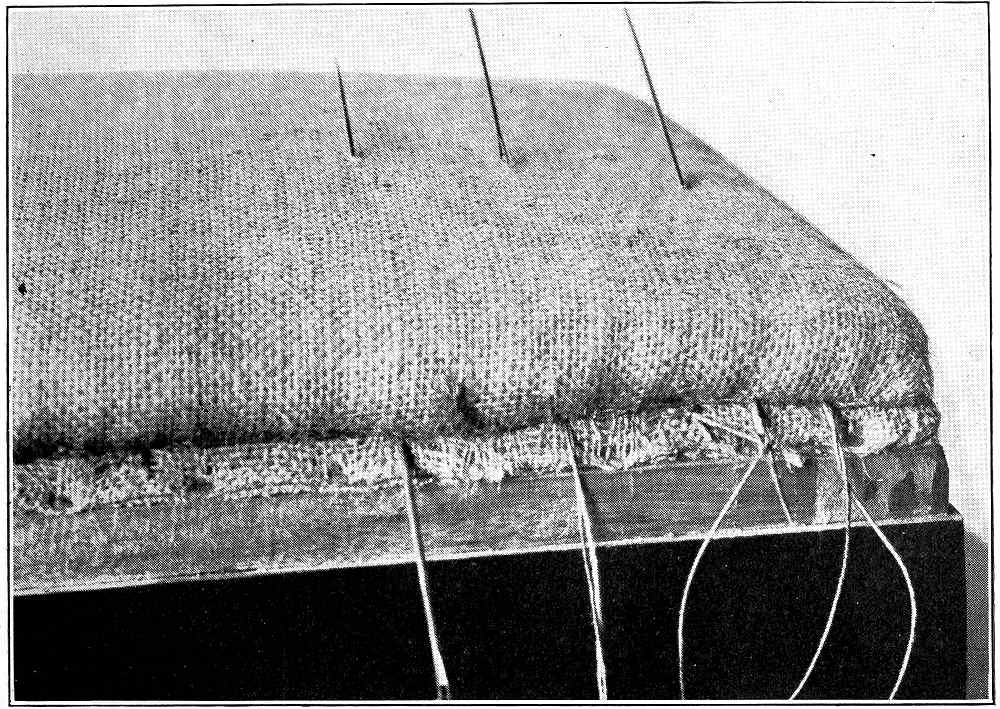
FIG. 43
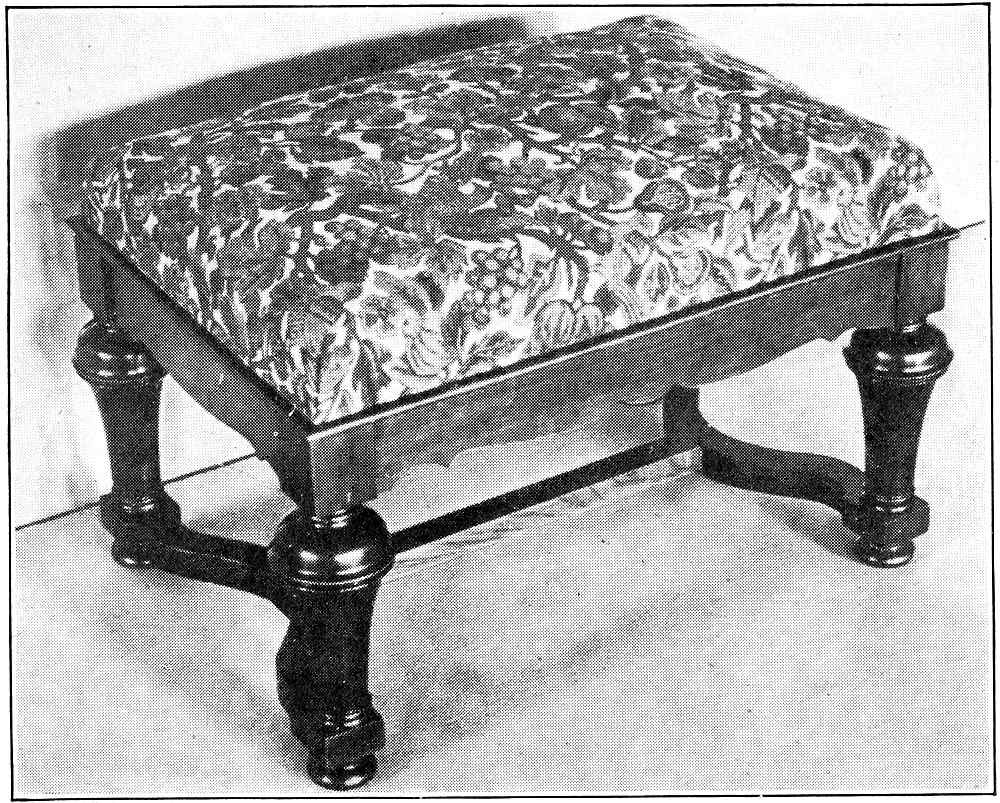
FIG. 44
[Pg 50]

FIG. 45
The first evidence of deterioration in much old spring upholstered furniture is a sagging seat. If attended to at the first indication of sag the fault may be remedied by simply retacking the webbing which most likely has pulled away from the rails. If the sag is not remedied shortly the stuffing begins to shift, and the exposed springs will soon cut or wear a hole thru the cover. Then the seat is practically beyond repair, with the exception of the utilization of the springs. Should the springs show evidence of rust, or if they have lost their temper and resiliency, new ones are required. The best policy is to repair a seat at the first indications of sag, providing the materials generally are worthy of repair.
In Fig. 45 is shown a small rocker with webbing and springs placed, and springs properly tied. This seat is a reconstruction job. Note that the cords are secured inside the rails, and that the webbing is tacked underneath the rails excepting on the front rail where it is fastened inside. This is necessary because of the curve on the bottom of the front rail. It shows the base for a hard-edge seat, and is treated in the same manner as the Queen Anne stool previously described. The one exception is that the goods are to be stretched over the faces of the rails and tacked underneath.
OLD FURNITURE.—Many heirlooms and other pieces of old furniture may be repaired by reglueing and replacing parts, or[Pg 51] by re-upholstering, and the whole refinished so that it will compare favorably with fine pieces of furniture. A piece of furniture of this kind is illustrated in Fig. 46. The treatment of the seat is somewhat different from that described before. The front edge has a hard edge, identical to that described in Chapter VI. The edges at the sides and back need no sewing; at least, they require very little stitching.
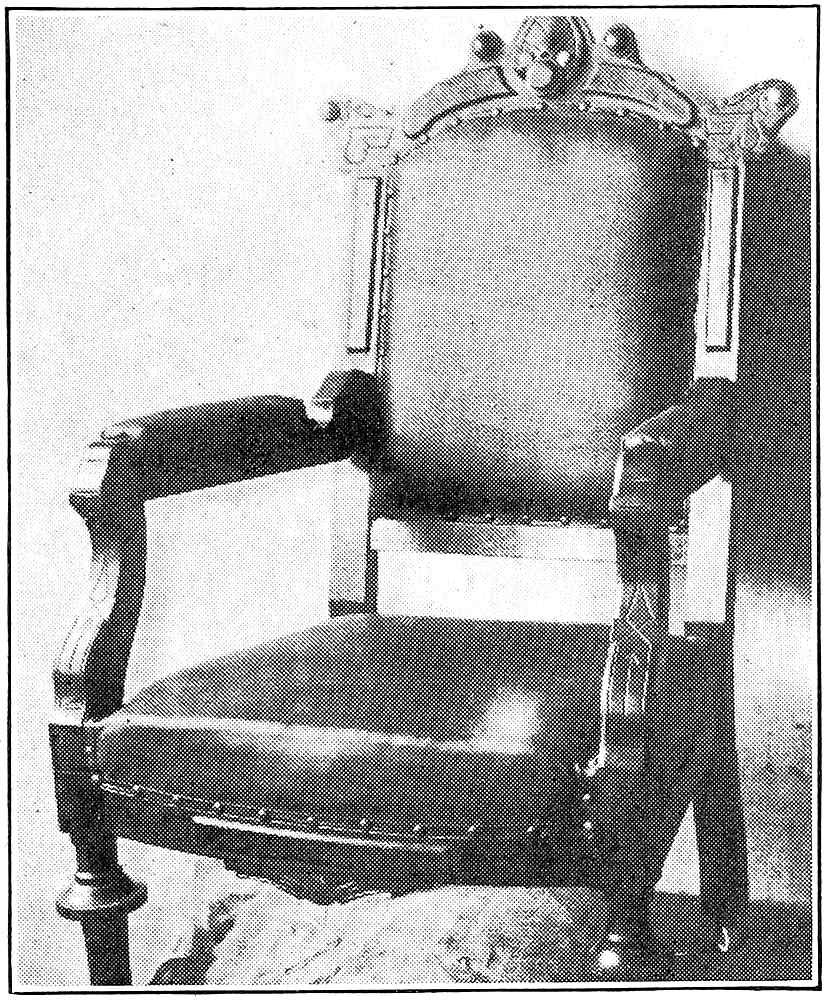
FIG. 46
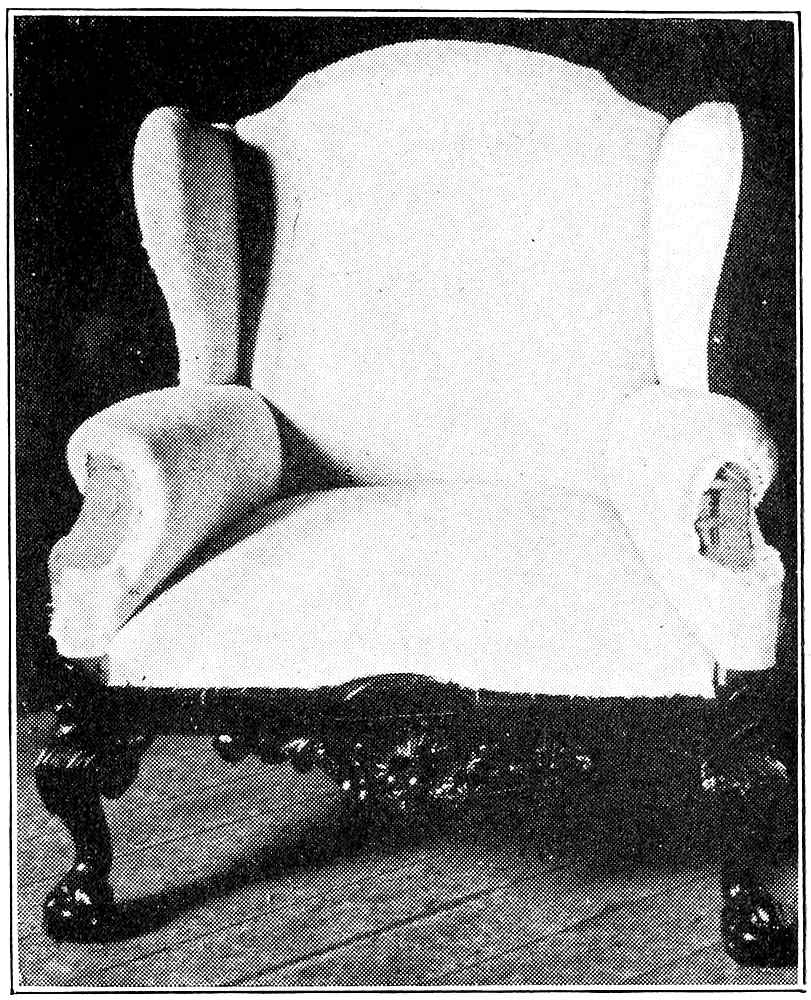
FIG. 47
The webbing is tacked on the inner edges of the back, otherwise the rabbet would prove too shallow to permit the gimp to run flush with the wood surface. The stuffing should be stitched to the burlap and webbing. This holds all firmly together.
To upholster the arms tack twine over the edges, forming loose loops into which stuffing may be placed. This twine holds the stuffing in place while the muslin is being tacked and the proper shape or form given to the arms. Then place the cover over this, carefully folding and drawing at the corners. Tack firmly in place and attach the gimp.
[Pg 52]
Fig. 47 illustrates an overstuffed chair. The processes described for making a hard-edge seat are followed on a chair of this kind. It requires patience to upholster, but when covered with a good piece of tapestry results in a very valuable and comfortable piece of furniture.
In Fig. 48 is illustrated a rocker which shows examples of both loose and attached pads on a single structure. The seat is a hard-edge loose pad, made in a manner identical to the cricket, but with a curved front which increases the difficulty of the work. The arms are loose pads held by means of dowels. The back pad is fastened to the frame by means of screws, secured before the back part of the cover is attached. With substantial upholstery work this type of chair is both serviceable and comfortable.

FIG. 48
[Pg 53]
The two examples of furniture illustrated in Fig. 49 are two types which are upholstered in a very different manner from any of the processes described thus far. This is spring-edge work, and is very generally employed on sofas, lounges and settees. In upholstery of this kind the springs must be placed flush with the outside of the frame. This necessitates bending the springs out somewhat.
Fig. 50 shows a chair of this type with webbing attached and the method of stitching the springs to the webbing. Note the spacing of the webbing. Fig. 51 shows a top view of the same seat. Notice that the springs are flush with the outside surface of the rail. The spring wire is shown attached and formed. This form must be accurately made for it determines the final outline of the seat. The wire is fastened near the ends to the upholstery blocks, with staples, and to the springs by means of stitching twine coiled and tied. There is on the market a certain metal clip for fastening the coil and wire together. These clips are attached by means of a pair of special pliers.
Fig. 52 shows the seat in a natural view. Note the method of tying the springs. This is different from the method previously described. The twine is brought down inside of a spring and tied to a second or third coil instead of over the outside top coil. This permits the top coil to lie horizontal, and braces the spring so it remains vertical. Fig. 51 also illustrates this method. A twine is also tacked to the top of the frame and carried up to the spring wire and down to the frame again. It is clearly shown in Fig. 52. This twine braces the springs and prevents sagging, and results in a vertical motion rather than partially horizontal when the seat is used.
[Pg 54]
Over this spring work a piece of burlap is then placed and tacked with 4-oz. tacks on the top edge of the frame, as illustrated in Fig. 53. This burlap must fit tight enough to be smooth, but care must be exercised that it does not fit so tight as to result in the pulling down of the springs. Next place a layer of tow over the burlap. Follow with another piece of burlap, and sew onto the spring wire instead of tacking to the frame as in a hard-edge seat. Next form the hard edge, and finish off with tow or moss as described previously.

FIG. 49
Fig. 54 shows the various steps in the building up of a seat. After the tow has been placed lay on a piece of blue sheet wadding or a layer of cotton batting. Lay the cover over this and tack it loosely upon the frame and upholstery blocks at the back; stretch toward the front and fasten underneath the spring wire with skewers,[Pg 55] and secure it in a similar manner at the sides. Then adjust it carefully; tack permanently at the back, and then sew just under the spring wire. These stitches may be seen at the left in Fig. 54.
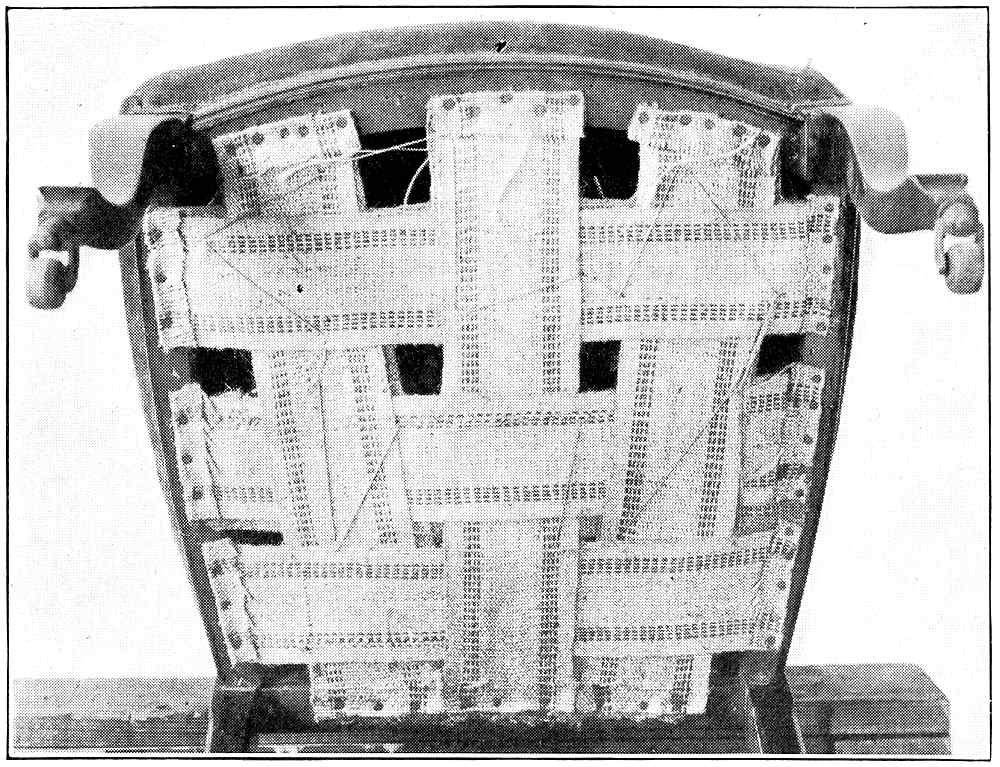
FIG. 50
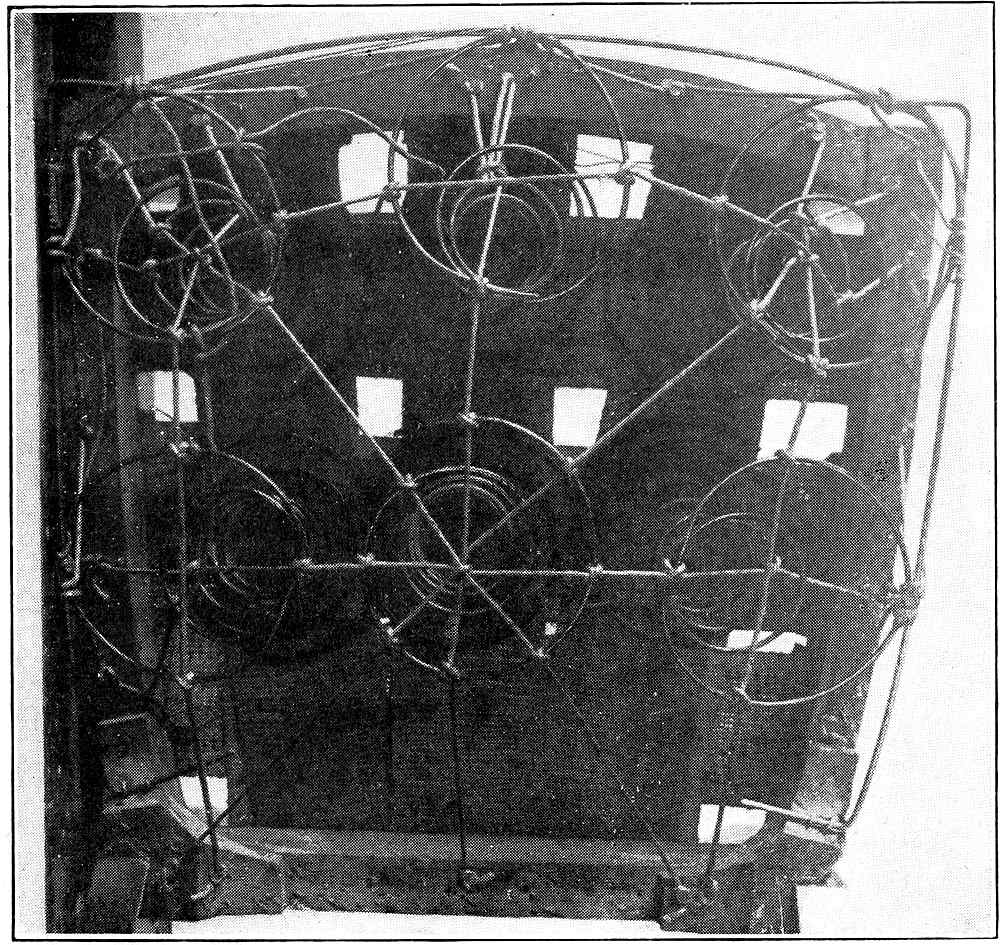
FIG. 51
[Pg 56]
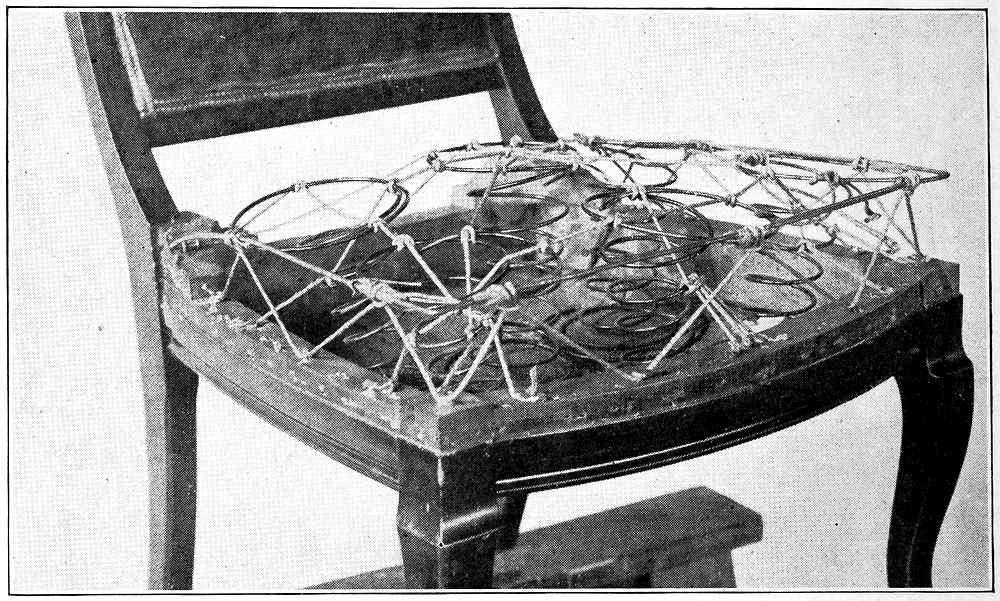
FIG. 52
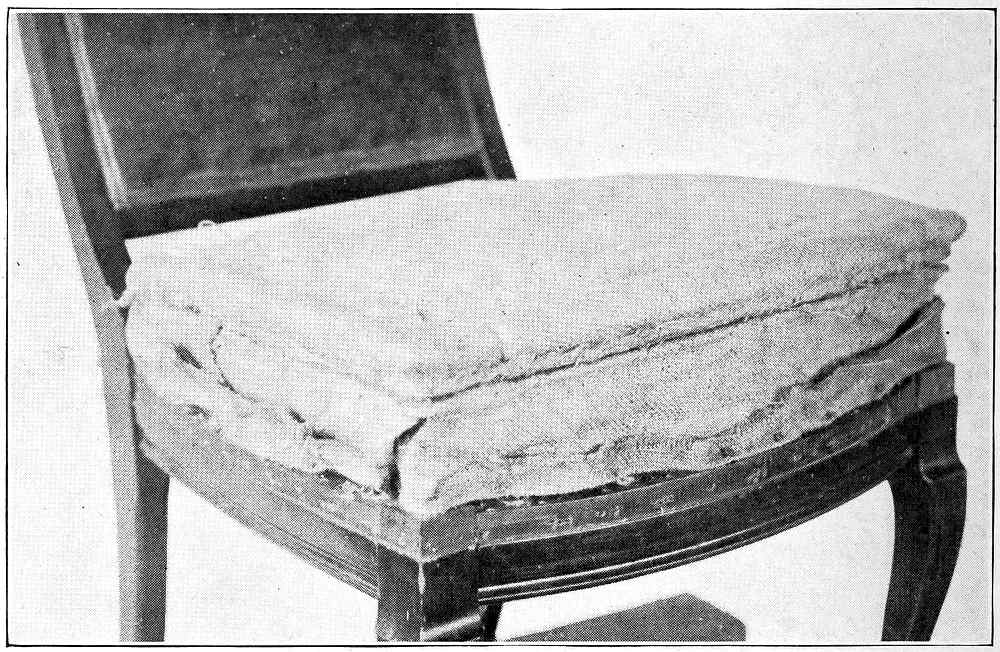
FIG. 53
[Pg 57]

FIG. 54
The next step is the placing of the welt edge. This edge is clearly shown in Fig. 55. Just below the turn of the top piece a beading may be seen. This is the welt edge, and immediately below is the band. In Fig. 54 is shown a close view of the welt edge. The process of making it is as follows: Fold a narrow strip of cloth around a soft cord. Hold it against the seat with the edges down; turn the band inside out and sew its lower edge. Run the curved needle thru it and the welting so that the seam comes immediately above the seam which fastens the top cover to the seat. Sew from right to left, for then the piece may be handled conveniently with the left hand while sewing is done with the right. Three pieces are manipulated in this work; the cord, the narrow band of cloth folded around the cord, and the front band. This process may be[Pg 58] simplified if a sewing machine is employed. Then the welting cord may be sewed into the top edge of the front band. When this is sewed to the chair seat but one piece remains to be managed.
The front band should be draped or folded at the corners. This fold may be noticed at the corners of the chair seat in Fig. 55, and it allows the band to run about the corner full and smooth. This is all the more necessary because some stuffing is placed behind the band to keep the band from falling in when the edge of the seat is pressed down.
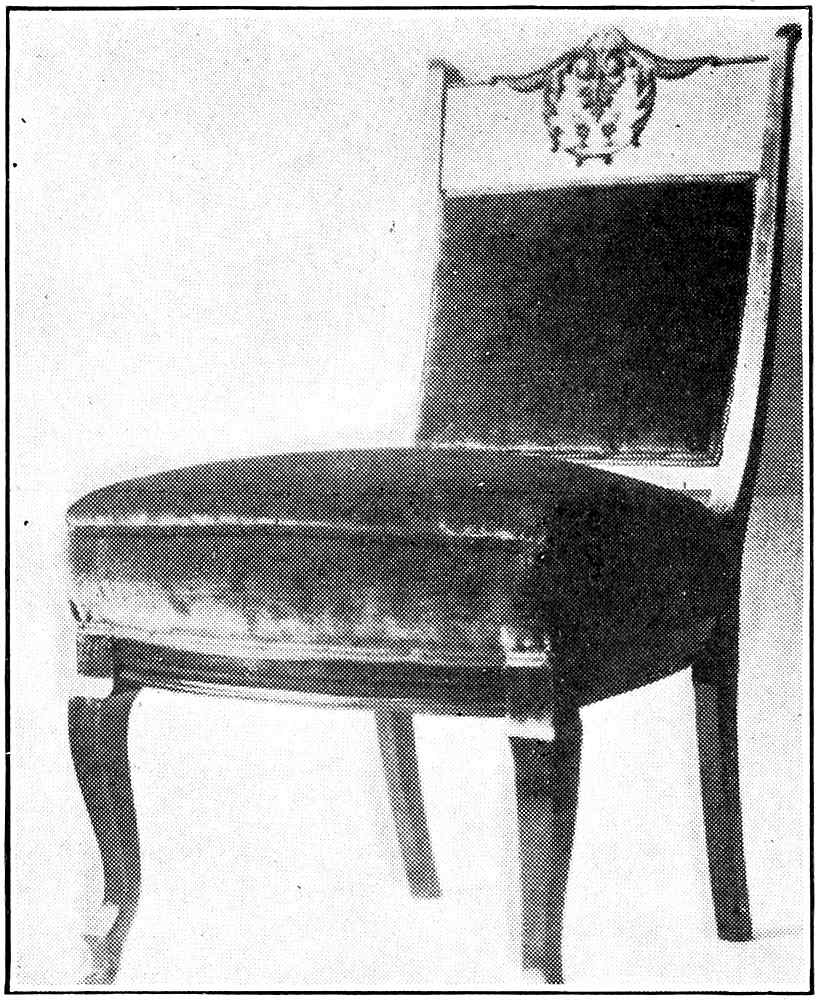
FIG. 55
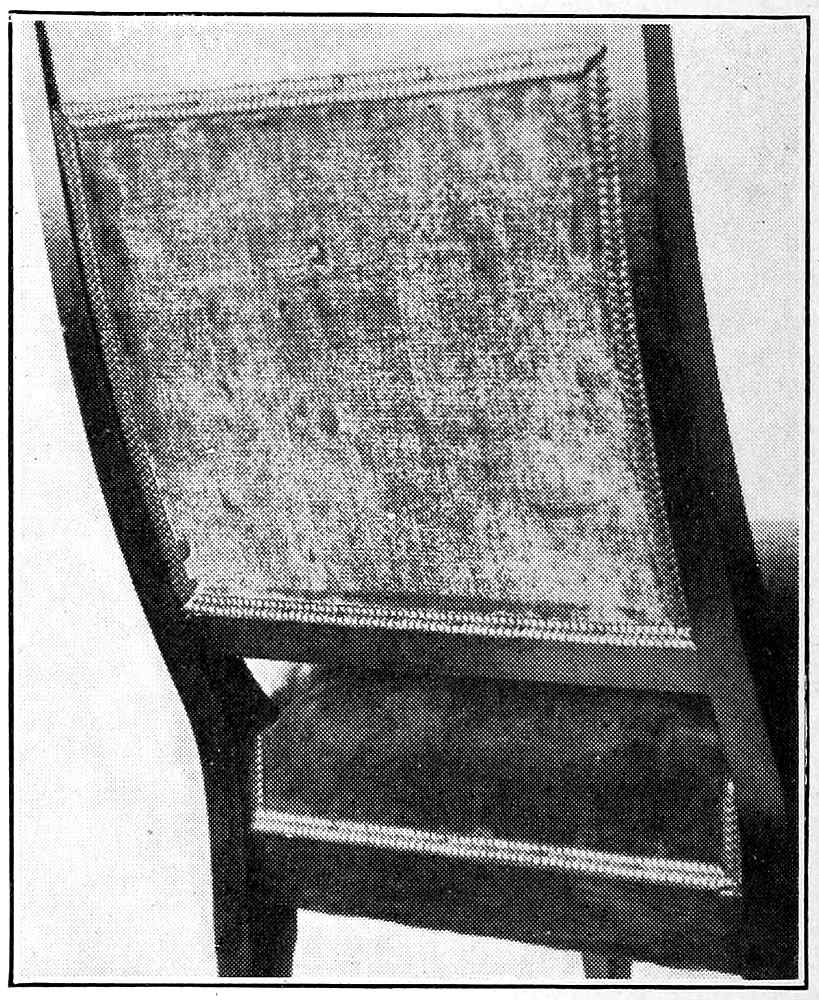
FIG. 56
In Fig. 56 is shown the gimp. It is generally fastened with gimp tacks, but in very fine work it is glued in place. Glueing has a distinct advantage where the gimp must be placed around curves for then it may run continuously rather than in a series of straight lines between tacks, as is necessary when tacks are employed.
In Fig. 57 are shown a series of problems in upholstery; in Fig. 58, the application of such type problems to structures of a distinctly useful nature.
[Pg 59]
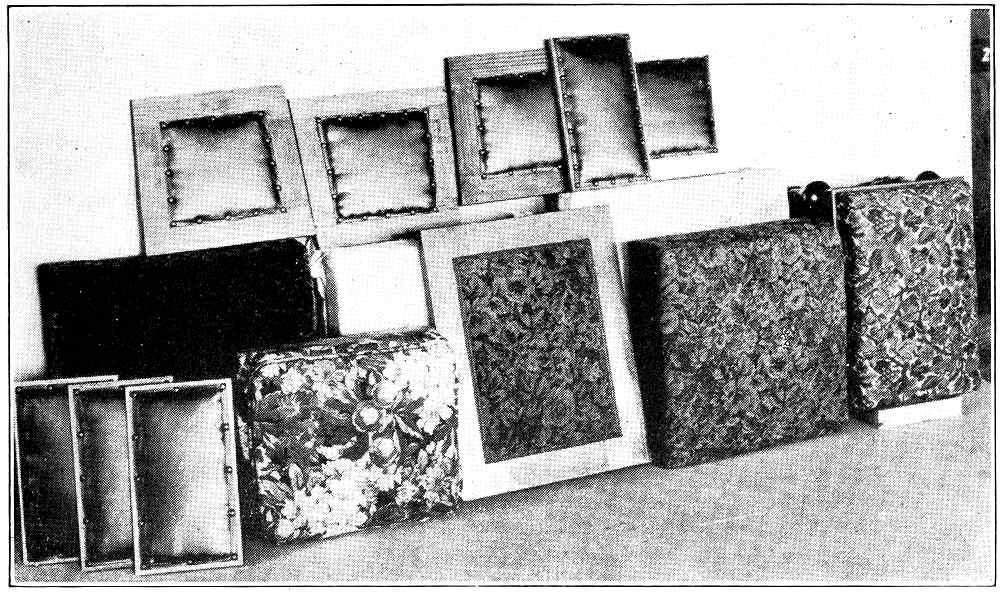
FIG. 57

FIG. 58
[Pg 60]
| GROUP I.—FIRST METHOD—UPHOLSTERING A PLAIN BOARD SURFACE. | ||
| Tool Processes | Topics For Class Discussion | Problems |
| Shaping stuffing: moss, tow, kapok, alva, cork shavings or excelsior. | Preliminary talks on upholstering tools. Preparation of stuffing. |
Footstool. Cart. Chest cover. Shirtwaist box. Box lid. |
| Stretching and tacking muslin or burlap cover. | Advantage of tacking and stretching goods from center toward corners. | |
| Covering with wadding or cotton batting. | The need of wadding or cotton. | |
| Attaching cover, imitation leather, genuine leather or textiles. | Different classes of covers appropriate for different uses. Cost, durability, appearance and comfort. | |
| Gimping. | Appropriate gimps for different covers. Nails: Metalene, Perfection and Leather. Spacing of nails. Method of folding gimp at corners. |
|
| GROUP I.—SECOND METHOD | ||
| Attaching burlap or webbing strips. Forming hard edges. |
Advantages of hard edges. | Leg rest. Footstool. |
| Placing of stuffing. | Desirable form to seat. | |
| Adjusting muslin. | Reason for use of muslin under cover. | |
| Placing of wadding. Placing of cover. Folding at corners. |
Gimp or no gimp. | |
| Placing and nailing of gimp. | ||
| GROUP II.—UPHOLSTERING A FRAMED STRUCTURE.[Pg 61] | ||
| Rounding inside edges of rails. | Advantages of rounding or chamfering arrises. | Footstool. Chair seat and back. Slip seats. |
| Tacking on webbing, or Attaching board bottom. | Comparison of webbing with board bottom. | |
| Attaching burlap. | Size of burlap to permit making of hard edge. | |
| Making hard edge. | ||
| Stuffing. | ||
| Tacking muslin over stuffing. | Reasons for loose or slip tacking. | |
| Regulating. | ||
| Covering with wadding or cotton batting. | ||
| Stretching and tacking outside cover. | All-over upholstery. Show wood upholstery. Welt edge work. |
|
| Tacking on cambric. | Need for cambric. | |
| GROUP III.—HARD-EDGE UPHOLSTERY.[Pg 62] | ||
| Tacking webbing in place, or Attaching slats. | Preventing the clicking of springs. | Easy chair. Settee seats. Cricket seats. |
| Placing springs. | Different sizes and shapes of springs for different uses. | |
| Sewing springs. | ||
| Tying springs. | Importance of well tied springs. | |
| Tacking on burlap. | ||
| Placing stuffing for hard edge. | Over-hang of stuffing. | |
| Tacking on light burlap. Sewing hard edge. |
Different methods of sewing. Constant regulating. |
|
| Evening seat with double stuffing and cotton. | ||
| Tacking on muslin. | ||
| Placing outside cover. | Blind sewing. | |
| Tacking on cambric. | ||
| GROUP IV.—SPRING-EDGE UPHOLSTERY.[Pg 63] | ||
| Attaching webbing, or Attaching slats. | Difference when compared with hard-edge work. | Side chair. Arm chair. Sofas and lounges. |
| Placing springs. | Difference in placement of springs when compared with hard-edge work. | |
| Attaching spring-wire edge. | ||
| Tying springs. | Difference between this and former work. | |
| Placing burlap. | ||
| Stuffing. | ||
| Placing burlap over stuffing. | ||
| Stitching edge. | ||
| Placing muslin. | Need of layer of cotton batting when hair is used for stuffing. | |
| Attaching outside cover. | ||
| Sewing welt edge. | Advantages of welt edge. | |
| Gimping. | Different methods of attaching gimp. | |
[Pg 64]
(NUMBERS REFER TO PAGES)
This eBook is for the use of anyone anywhere in the United States and most other parts of the world at no cost and with almost no restrictions whatsoever. You may copy it, give it away or re-use it under the terms of the Project Gutenberg License included with this eBook or online at www.gutenberg.org. If you are not located in the United States, you will have to check the laws of the country where you are located before using this eBook.